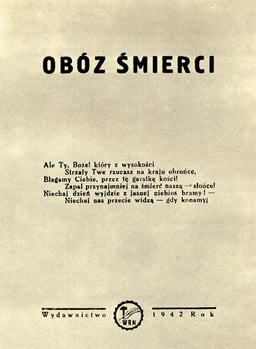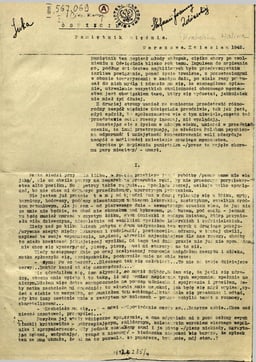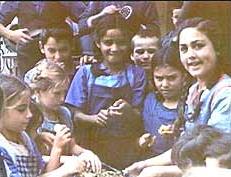Auschwitz concentration camp
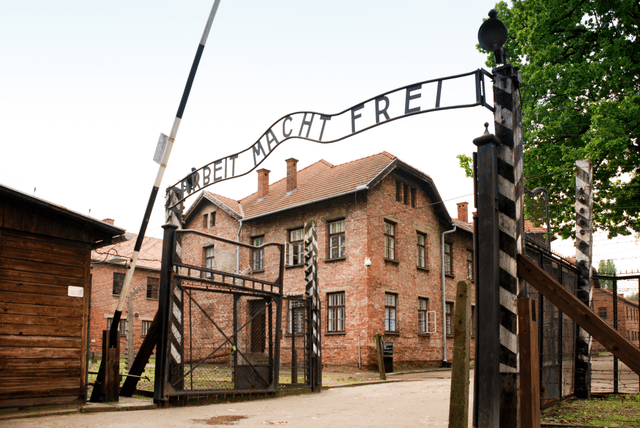
Auschwitz concentration camp

| Auschwitz | |
|---|---|
| Nazi concentration and extermination camp (1940–1945) | |
 Top: The Arbeit macht frei ("work sets you free") gate to Auschwitz I, the main campAbove: Train track, in operation May–October 1944, leading through the gate to the gas chambers at Auschwitz II-Birkenau[11] | |
| Video | Drone footage, 2015 [333] |
| Images | Google Earth [334] |
| Coordinates | 50°02′09″N 19°10′42″E [335] |
| German name | Konzentrationslager Auschwitz (pronounced[kɔntsɛntʁaˈtsi̯oːnsˌlaːɡɐ ˈʔaʊʃvɪts](listen)); also *KZ Auschwitz
|
| Known for | The Holocaust |
| Location | Oświęcim (German: Auschwitz), German-occupied Poland |
| Operated by | Nazi Germany and the Schutzstaffel |
| Founding commandant | Rudolf Höss |
| Original use | Army barracks |
| Operational | May 1940 – January 1945 |
| Inmates | Mainly Jews, Poles, Romani, Soviet prisoners of war |
| Number of inmates | At least 1.3 million |
| Killed | At least 1.1 million |
| Liberated by | Soviet Union, 27 January 1945 |
| Notable inmates | Adolf Burger, Anne Frank, Otto Frank, Viktor Frankl, Imre Kertész, Maximilian Kolbe, Primo Levi, Irène Némirovsky, Witold Pilecki, Edith Stein, Simone Veil, Rudolf Vrba, Alfréd Wetzler, Elie Wiesel, Fritz Löhner-Beda, Else Ury |
| Notable books |
|
| Website | auschwitz.org/en/ [336] |
| Official name | Auschwitz Birkenau, German Nazi Concentration and Extermination Camp (1940–1945) |
| Type | Cultural |
| Criteria | vi |
| Designated | 1979(3rd session) |
| Reference no. | 31 [337] |
| Region | Europe and North America |
The Auschwitz concentration camp (Konzentrationslager Auschwitz) was a complex of over 40 concentration and extermination camps built and operated by Nazi Germany in occupied Poland during World War II and the Holocaust. It consisted of Auschwitz I, the main camp (Stammlager) and administrative headquarters in Oświęcim; Auschwitz II–Birkenau, a combined concentration and extermination camp three kilometers away in Brzezinka; Auschwitz III–Monowitz, a labor camp created to staff an IG Farben synthetic-rubber factory; and dozens of other subcamps.[12]
After Germany invaded Poland in September 1939, sparking World War II, the Germans converted Auschwitz I, a former army barracks, to hold Polish political prisoners.[13] The first prisoners, German criminals brought to the camp as functionaries, arrived in May 1940,[14] and the first gassing of prisoners took place in block 11 of Auschwitz I in September 1941. Auschwitz II–Birkenau went on to become a major site of the Nazis' Final Solution to the Jewish Question. From early 1942 until late 1944, transport trains delivered Jews from all over German-occupied Europe to the camp's gas chambers. Of the estimated 1.3 million people sent to Auschwitz, at least 1.1 million died,[15] around 90 percent of them Jews.[16] Approximately one in six Jews killed in the Holocaust died at the camp.[17] Others deported to Auschwitz included 150,000 non-Jewish Poles, 23,000 Roma, 15,000 Soviet prisoners of war, 400 Jehovah's Witnesses, tens of thousands of others of diverse nationalities, and an unknown number of gay men. Many of those not killed in the gas chambers died because of starvation, forced labor, infectious diseases, individual executions, and medical experiments.
In the course of the war, the camp was staffed by 7,000 members of the German Schutzstaffel (SS), approximately 12 percent of whom were later convicted of war crimes; several, including camp commandant Rudolf Höss, were executed. The Allies did not act on early reports of atrocities at the camp, and their failure to bomb the camp or its railways remains controversial. At least 802 prisoners tried to escape from Auschwitz, 144 successfully, and on 7 October 1944 two Sonderkommando units, consisting of prisoners assigned to staff the gas chambers, launched a brief, unsuccessful uprising.
As Soviet troops approached Auschwitz in January 1945, most of its population was sent west on a death march. The remaining prisoners were liberated on 27 January 1945, a day commemorated as International Holocaust Remembrance Day. In the following decades, survivors such as Primo Levi, Viktor Frankl, and Elie Wiesel wrote memoirs of their experiences in Auschwitz, and the camp became a dominant symbol of the Holocaust. In 1947 Poland founded the Auschwitz-Birkenau Memorial and Museum on the site of Auschwitz I and II, and in 1979 it was named a World Heritage Site by UNESCO.
| Auschwitz | |
|---|---|
| Nazi concentration and extermination camp (1940–1945) | |
 Top: The Arbeit macht frei ("work sets you free") gate to Auschwitz I, the main campAbove: Train track, in operation May–October 1944, leading through the gate to the gas chambers at Auschwitz II-Birkenau[11] | |
| Video | Drone footage, 2015 [333] |
| Images | Google Earth [334] |
| Coordinates | 50°02′09″N 19°10′42″E [335] |
| German name | Konzentrationslager Auschwitz (pronounced[kɔntsɛntʁaˈtsi̯oːnsˌlaːɡɐ ˈʔaʊʃvɪts](listen)); also *KZ Auschwitz
|
| Known for | The Holocaust |
| Location | Oświęcim (German: Auschwitz), German-occupied Poland |
| Operated by | Nazi Germany and the Schutzstaffel |
| Founding commandant | Rudolf Höss |
| Original use | Army barracks |
| Operational | May 1940 – January 1945 |
| Inmates | Mainly Jews, Poles, Romani, Soviet prisoners of war |
| Number of inmates | At least 1.3 million |
| Killed | At least 1.1 million |
| Liberated by | Soviet Union, 27 January 1945 |
| Notable inmates | Adolf Burger, Anne Frank, Otto Frank, Viktor Frankl, Imre Kertész, Maximilian Kolbe, Primo Levi, Irène Némirovsky, Witold Pilecki, Edith Stein, Simone Veil, Rudolf Vrba, Alfréd Wetzler, Elie Wiesel, Fritz Löhner-Beda, Else Ury |
| Notable books |
|
| Website | auschwitz.org/en/ [336] |
| Official name | Auschwitz Birkenau, German Nazi Concentration and Extermination Camp (1940–1945) |
| Type | Cultural |
| Criteria | vi |
| Designated | 1979(3rd session) |
| Reference no. | 31 [337] |
| Region | Europe and North America |
Background
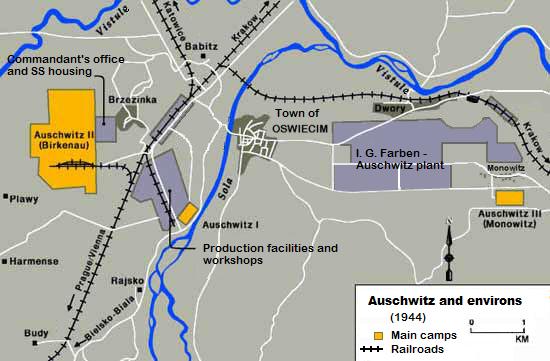
Auschwitz I, II, and III
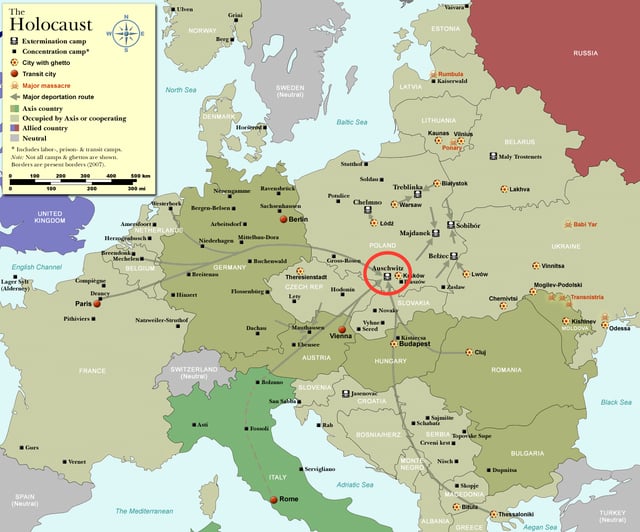
Concentration camps and ghettos in occupied Europe (2007 borders); same map showing WWII borders
The ideology of Nazism brought together elements of antisemitism, racial hygiene and eugenics, and combined them with pan-Germanism and territorial expansionism with the goal of obtaining more Lebensraum (living space) for the Germanic people.[18] Immediately after the Nazi seizure of power in Germany, boycotts of German Jews and acts of violence against them became ubiquitous,[19] and legislation was passed excluding them from the civil service and certain professions, including the law.[20][1] Harassment and economic pressure were used to encourage them to leave Germany; their businesses were denied access to markets, forbidden to advertise in newspapers, and deprived of government contracts.[21]
On 15 September 1935, the Reichstag passed the Nuremberg Laws, prohibiting marriages between Jews and people of Germanic extraction, extramarital relations between Jews and Germans, and the employment of German women under the age of 45 as domestic servants in Jewish households.[22] The Reich Citizenship Law defined as citizens those of "German or kindred blood". Thus Jews and other minorities were stripped of their citizenship.[23] By the start of World War II in 1939, around 250,000 of Germany's 437,000 Jews had emigrated to the United States, Palestine, the United Kingdom, and other countries.[24][25]
When Germany invaded Poland in September 1939, triggering World War II, Adolf Hitler ordered that the Polish leadership and intelligentsia be destroyed.[26] Approximately 65,000 civilians, viewed as inferior to the Aryan master race, had been killed by the end of 1939. In addition to leaders of Polish society, the Nazis killed Jews, prostitutes, the Roma, and the mentally ill.[27][28] SS-Obergruppenführer Reinhard Heydrich, then head of the Gestapo, ordered on 21 September 1939 that Polish Jews be rounded up and concentrated into cities with good rail links. Initially the intention was to deport them to points further east, or possibly to Madagascar.[29] Two years later, in June 1941, in an attempt to obtain new territory, Hitler invaded the Soviet Union.[18]
Camps
Auschwitz I
Growth
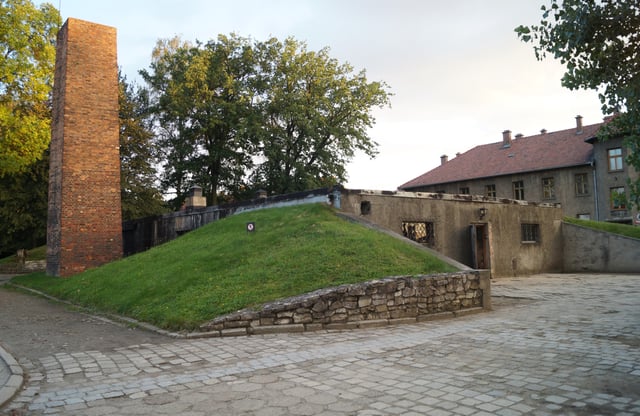
Crematorium I, 2016
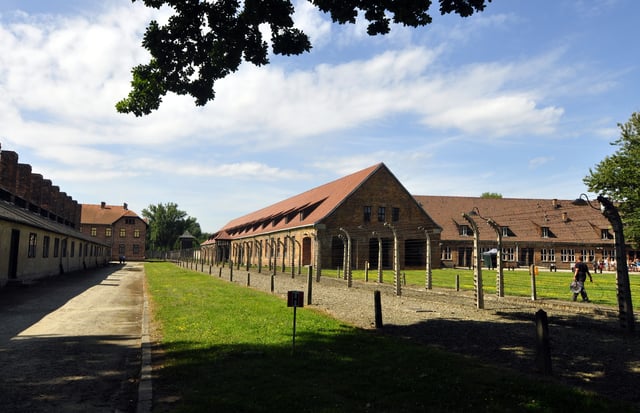
Former prisoner reception centre; the building on the far left with the row of chimneys was the camp kitchen.
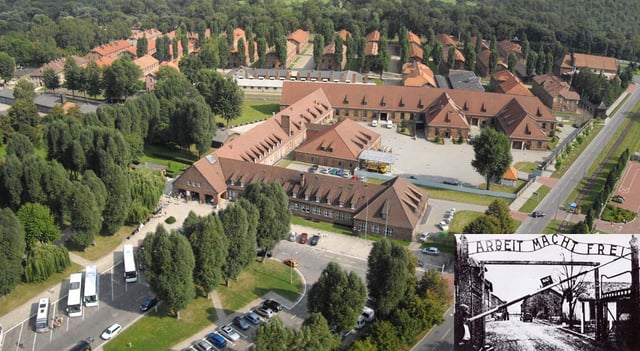
Auschwitz I, 2009; the prisoner reception center of Auschwitz I became the visitor reception center of the Auschwitz-Birkenau Memorial and Museum.[30]
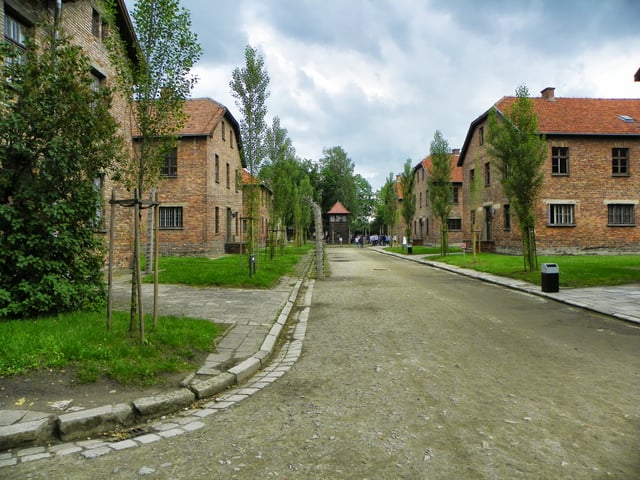
Auschwitz I, 2013 (50°01′39″N 19°12′11″E [338] )
Auschwitz I, a former Polish army barracks, was the main camp (Stammlager) and administrative headquarters of the camp complex. Intending to use it to house political prisoners, Reichsführer-SS Heinrich Himmler, head of the Schutzstaffel (SS), approved the site in April 1940 on the recommendation of SS-Obersturmbannführer (lieutenant colonel) Rudolf Höss, then of the Concentration Camps Inspectorate. Höss oversaw the development of the camp and served as its first commandant, with SS-Obersturmführer (senior lieutenant) Josef Kramer as his deputy.[31] Around 1,000 m long and 400 m wide,[32] Auschwitz I consisted of 20 brick buildings, six of them two-story; a second story was added to the others in 1943 and eight new blocks were built.[33] The camp housed the SS barracks and by 1943 held 30,000 inmates.[32]
The first 30 prisoners arrived on 20 May 1940 after being transported from the Sachsenhausen concentration camp in Oranienburg, Germany. Convicted German criminals (Berufsverbrecher), the men were known as "greens" after the green triangles they were required to wear on their prison clothing. Brought to the camp as functionaries, this group did much to establish the sadism of early camp life, which was directed particularly at Polish inmates, until the political prisoners began to take over their roles.[14] Bruno Brodniewitsch, the first prisoner, became Lagerältester (camp elder), and the others were given positions such as kapo and block supervisor.[34]
The first mass transport of 728 Polish male political prisoners, including Catholic priests and Jews, arrived on 14 June 1940 from Tarnów, Poland. They were given serial numbers 31 to 758.[2] By the end of 1940, the SS had confiscated land around the camp to create a 40-square-kilometre (15 sq mi) "zone of interest" surrounded by a double ring of electrified barbed wire fences and watchtowers.[36] The inmate population grew quickly. By March 1941, 10,900 were imprisoned there, most of them Poles.[32]
An inmate's first encounter with the camp, if they were being registered and not sent straight to the gas chamber, would be at the prisoner reception centre, where they were tattooed, shaved, disinfected, and given their striped prison uniform. Built between 1942 and 1944, the center contained a bathhouse, laundry, and 19 gas chambers for delousing clothes. Debórah Dwork and Robert Jan van Pelt write that inmates would then leave this area via a porch that faced the gate with the Arbeit macht frei sign. The prisoner reception center of Auschwitz I became the visitor reception center of the Auschwitz-Birkenau Memorial and Museum.[30]
Crematorium I, first gassing
Construction of crematorium I began at Auschwitz I at the end of June or beginning of July 1940.[37] Initially intended not for mass murder but for prisoners who had been executed or had otherwise died in the camps, the crematorium was in operation from August 1940 until July 1943, by which time the crematoria at Auschwitz II had taken over.[38] By May 1942 three ovens had been installed in crematorium I, which together could burn 340 bodies in 24 hours.[39]
The first experimental gassing took place in September 1941, when Lagerführer Karl Fritzsch, at the instruction of Rudolf Höss, killed a group of Soviet prisoners of war by throwing Zyklon B crystals into their basement cell in block 11 of Auschwitz I. A second group of 600 Soviet prisoners of war and around 250 sick Polish prisoners was gassed on 3–5 September.[40] The morgue was later converted to a gas chamber able to hold at least 700–800 people.[41] Zyklon B was dropped into the room through slits in the ceiling.[39] In the view of Filip Müller, one of the Sonderkommando who worked in crematorium I, tens of thousands of Jews were killed there from France, Holland, Slovakia, Upper Silesia, Yugoslavia, and from the Theresienstadt, Ciechanow, and Grodno ghettos.[42] The last inmates to be gassed in Auschwitz I, in December 1942, were 300–400 members of the Auschwitz II Sonderkommando, who had been forced to dig up that camp's mass graves, thought to hold 100,000 corpses, and burn the remains.[43]
History of the site
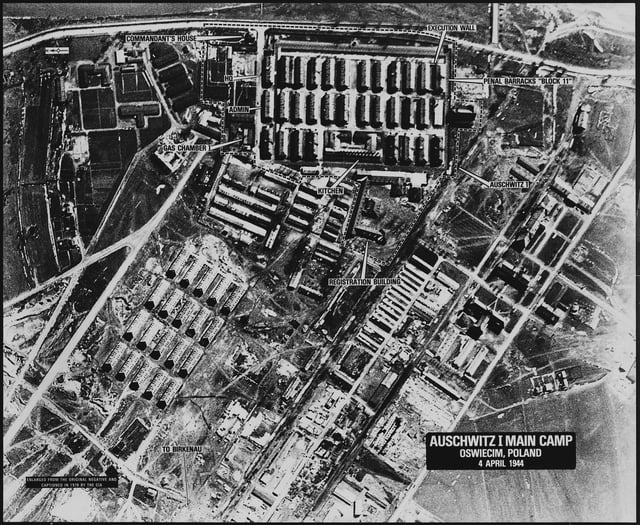
Auschwitz I, 4 April 1944
The site was first suggested as a concentration camp for Polish prisoners by SS-Oberführer Arpad Wigand, an aide to Erich von dem Bach-Zelewski, Higher SS and Police Leader for Silesia. After this part of Poland was annexed by Nazi Germany, Oświęcim (Auschwitz) was located administratively in Germany, in the Province of Upper Silesia, Regierungsbezirk Kattowitz, Landkreis Bielitz. Bach-Zelewski had been searching for a site to hold prisoners in the Silesia region, as the local prisons were filled to capacity. Richard Glücks, head of the Concentration Camps Inspectorate, sent former Sachsenhausen concentration camp commandant Walter Eisfeld to inspect the site, which housed 16 dilapidated one-story buildings that had served as an Austrian and later Polish Army barracks and a camp for transient workers.[13] German citizens were offered tax concessions and other benefits if they would relocate to the area.[44] By October 1943, more than 6,000 Reich Germans had arrived.[45] The Nazis planned to build a model modern residential area for incoming Germans, including schools, playing fields, and other amenities. Some of the plans went forward, including the construction of several hundred apartments, but many were never fully implemented.[46] Basic amenities such as water and sewage disposal were inadequate, and water-borne illnesses were commonplace.[47]
Auschwitz II-Birkenau
Construction and operation
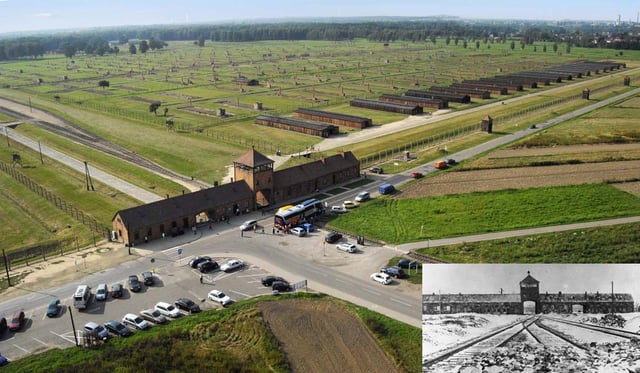
Gate with the camp remains in the background, 2009

The same scene, May or June 1944, with the gate in the background. "Selection" of Hungarian Jews on the Judenrampe, chosen either for work or the gas chamber. Photograph from the Auschwitz Album.
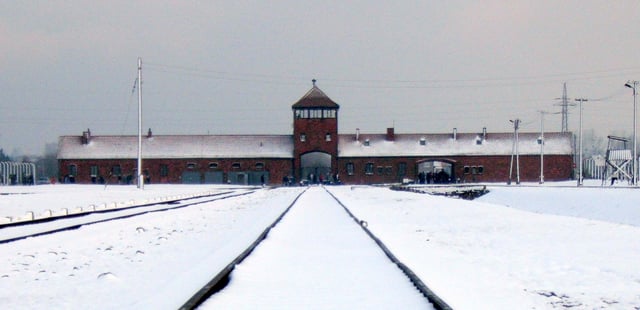
Auschwitz II-Birkenau gate from inside the camp, 2007
The victories of Operation Barbarossa in the summer and fall of 1941 against Hitler's new enemy, the Soviet Union, led to dramatic changes in Nazi anti-Jewish ideology and the profile of prisoners brought to Auschwitz.[48] Construction on Auschwitz II-Birkenau began in October 1941 to ease congestion at the main camp. Reichsführer-SS Heinrich Himmler, head of the Schutzstaffel (SS), intended the camp to house 50,000 prisoners of war, who would be interned as forced laborers. Plans called for the expansion of the camp first to house 150,000 and eventually as many as 200,000 inmates.[49] An initial contingent of 10,000 Soviet prisoners of war arrived at Auschwitz I in October 1941, but by March 1942 only 945 were still alive, and these were transferred to Birkenau, where most of them died from disease or starvation by May.[50] By this time the Nazis had decided to annihilate the Jewish people,[51] so Birkenau became a labor and extermination camp.[50][52]
The chief of construction of Auschwitz II-Birkenau was Karl Bischoff, a competent and dynamic bureaucrat who, in spite of the ongoing war, carried out the construction deemed necessary. The Birkenau camp, the four crematoria, a new reception building, and hundreds of other buildings were planned and constructed.[53] Bischoff's plans, based on an initial budget of RM 8.9 million, called for each barracks to hold 550 prisoners. He later changed this to 744 per barracks, which meant the camp could hold 125,000, rather than 97,000.[54] The SS designed the barracks not so much to house people as to destroy them.[53] There were 174 barracks, each measuring 35.4 by 11.0 metres (116 by 36 ft), divided into 62 bays of 4 square metres (43 sq ft). The bays were divided into "roosts", initially for three inmates and later for four. With personal space of 1 square metre (11 sq ft) to sleep and place whatever belongings they had, inmates were deprived, Robert-Jan van Pelt wrote, "of the minimum space needed to exist".[55]
Crematoria II–V
The first gas chamber at Birkenau was in what prisoners called the "little red house" (known as bunker 1 by the SS), a brick cottage that had been converted into a gassing facility. The windows were bricked up and its four rooms converted into two insulated rooms, the doors of which said "Zur Desinfektion" ("to disinfection"). It was operational by March 1942. A second brick cottage, the "little white house" or bunker 2, was converted and operational by June 1942.[56] When Himmler visited the camp on 17 and 18 July 1942, he was given a demonstration of a selection of Dutch Jews, a mass killing in a gas chamber in bunker 2, and a tour of the building site of the new IG Farben plant being constructed at the nearby town of Monowitz.[57]
Use of bunkers I and 2 stopped in spring 1943 when the new crematoria were built, although bunker 2 became operational again in May 1944 for the murder of the Hungarian Jews.[58] Crematorium II, which had been designed as a mortuary with morgues in the basement and ground-level incinerators, was converted by installing gas-tight doors, vents for the Zyklon B to be dropped into the chamber, and ventilation equipment to remove the gas thereafter.[59] It went into operation in March 1943. Crematorium III was built using the same design. Crematoria IV and V, designed from the start as gassing centers, were also constructed that spring. By June 1943, all four crematoria were operational. Most of the victims were killed using these four structures.[60]
Auschwitz III-Monowitz

Detailed map of Buna Werke, Monowitz, and nearby subcamps
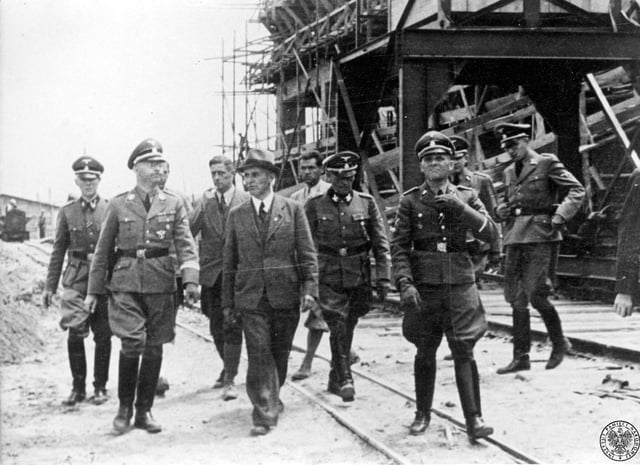
Heinrich Himmler (second left) visits the IG Farben plant in Auschwitz III, July 1942.
After examining several sites for a new plant to manufacture Buna-N, a type of synthetic rubber essential to the war effort, the German chemical cartel IG Farben chose a site near the towns of Dwory and Monowice (Monowitz in German), about 7 kilometres (4.3 mi) east of Auschwitz I.[61] Tax exemptions were available to corporations prepared to develop industries in the frontier regions under the Eastern Fiscal Assistance Law, passed in December 1940. The site had good railway connections and access to raw materials.[62] In February 1941, Himmler ordered that the Jewish population of Oświęcim be expelled to make way for skilled laborers; that all Poles able to work remain in the town and work on building the factory; and that Auschwitz prisoners be used in the construction work.[63]
Auschwitz inmates began working at the plant, known as Buna Werke and IG Auschwitz, in April 1941, and demolishing houses in Monowitz to make way for it. By May, because of a shortage of trucks, several hundred of them were rising at 3 am to walk there twice a day from Auschwitz I.[64] Anticipating that a long line of exhausted inmates walking through the town of Oświęcim might harm German-Polish relations, the inmates were told to shave daily, make sure they were clean, and sing as they walked. From late July they were taken there by train on freight wagons.[65] Because of the difficulty of moving them, including during the winter, IG Farben decided to build a camp at the plant. The first inmates moved there on 30 October 1942.[66] Known as KL Auschwitz III-Aussenlager (Auschwitz III-subcamps), and later as Monowitz concentration camp,[67] it was the first concentration camp to be financed and built by private industry.[68]
Measuring 270 by 490 metres (890 ft × 1,610 ft), the camp was larger than Auschwitz I. By the end of 1944, it housed 60 barracks measuring 17.5 by 8 metres (57 ft × 26 ft), each with a day room and a sleeping room containing 56 three-tiered wooden bunks.[69] IG Farben paid the SS three or four Reichsmark for nine- to eleven-hour shifts from each worker.[70] In 1943–1944, about 35,000 inmates worked at the plant; 23,000 (32 a day on average) died as a result of malnutrition, disease, and the workload.[71] Deaths and transfers to Birkenau reduced the population by nearly a fifth each month;[72] site managers constantly threatened inmates with the gas chambers.[70] In addition to the Auschwitz inmates, who comprised a third of the work force, IG Auschwitz employed slave laborers from all over Europe.[73] When the camp was liquidated in January 1945, 9,054 out of the 9,792 inmates were Jews.[74]
Although the factory had been expected to begin production in 1943, shortages of labor and raw materials meant start-up had to be postponed repeatedly.[75] The Allies bombed the plant in 1944 on 20 August, 13 September, 18 December, and again on 26 December. On 19 January 1945, the SS ordered that the site be evacuated, sending 9,000 inmates on a death march to another Auschwitz subcamp at Gliwice.[76] The plant had almost been ready to commence production.[77] From Gliwice, prisoners were taken by rail in open freight wagons to Buchenwald and Mauthausen concentration camps. The 800 inmates who had been left behind in the Monowitz hospital were liberated on 27 January 1945 by the 1st Ukrainian Front of the Red Army.[78]
Other subcamps
Various other German industrial enterprises, such as Krupp and Siemens-Schuckert, built factories with their own subcamps.[79] There were around 40[80] or 50[81] such camps, 28 of them near industrial plants, each camp holding hundreds or thousands of prisoners.[82] Designated as Aussenlager (external camp), Nebenlager (extension or subcamp), or Arbeitslager (labor camp),[80] camps were built at Blechhammer, Jawiszowice, Jaworzno, Lagisze, Mysłowice, Trzebinia, and centers as far afield as the Protectorate of Bohemia and Moravia in Czechoslovakia.[83][84][85] Industries with satellite camps included coal mines, foundries and other metal works, and chemical plants. Prisoners were also made to work in forestry and farming.[86] Budy, for example, was a farming subcamp where prisoners worked 12-hour days, often in the fields, but sometimes tending animals, cleaning ponds, digging ditches, and making compost. Human ashes from the crematorium were mixed with sod and manure to make the compost.[87] Incidents of sabotage to decrease production took place in several subcamps, including Charlottengrube, Gleiwitz II, and Rajsko.[88]
Life in the camps
Command and control

Rudolf Höss, the first commandant of Auschwitz
Born in Baden-Baden in 1900,[89] SS Obersturmbannführer Rudolf Höss became the first commandant of Auschwitz when the camp was founded in April 1940,[90] living with his wife and children in a villa just outside the camp grounds.[91] Appointed by Heinrich Himmler, he served until 11 November 1943, when he became director of Office DI of the SS-Wirtschafts-und Verwaltungshauptamt (SS Business and Administration Head Office or WVHA) in Oranienburg.[90] This post made Höss deputy of the Concentration Camps Inspectorate, under SS-Gruppenführer Richard Glücks.[92] He returned to Auschwitz between 8 May and 29 July 1944 as commander of the SS garrison (Standortältester) to oversee the arrival of Hungary's Jews, a post that made him the superior officer of all the commandants of the Auschwitz camps.[93]
Höss was succeeded as Auschwitz commandant in November 1943 by SS Obersturmbannführer Arthur Liebehenschel, who served until 15 May 1944. SS Sturmbannführer Richard Baer became commandant of Auschwitz I on 11 May 1944, and SS Obersturmbannführer Fritz Hartjenstein of Auschwitz II from 22 November 1943, followed by SS Obersturmbannführer Josef Kramer from 15 May 1944 until the camp's liquidation in January 1945. Heinrich Schwarz was commandant of Auschwitz III from the point at which it became an autonomous camp in November 1943 until its liquidation.[94]
Around 7,000 SS personnel were posted to Auschwitz during the war.[95] Of these, 4 percent of SS personnel were officers and 26 percent were non-commissioned officers, while the remainder were rank-and-file members.[96] Camp guards were members of the SS-Totenkopfverbände (Death's Head Units).[97] Approximately three in four SS personnel worked in security. Others worked in the medical or political departments, in the camp headquarters, or in the economic administration, which was responsible for the property of dead prisoners.[96] SS personnel at the camp included 200 women, who worked as guards, nurses, or messengers.[91] About 120 SS personnel were assigned to the gas chambers and lived on site at the crematoria.[98]
Auschwitz was considered a comfortable posting by many SS members, because of its many amenities.[95] SS personnel were initially allowed to bring partners, spouses, and children to live at the camp, but when the SS camp grew more crowded, Höss restricted further arrivals. Facilities for the SS personnel and their families included a library, swimming pool, coffee house, and a theater that hosted regular performances.[91]
Some prisoners—usually Aryan—were assigned positions of authority, such as Blockschreiber ("block clerk"), Funktionshäftling ("functionary"), Kapo ("head" or "overseer"), and Stubendienst ("barracks orderly"). They were considered members of the camp elite, and had better food and lodgings than the other prisoners. The Kapos in particular wielded tremendous power over other prisoners, whom they often abused.[99][100] Very few Kapos were prosecuted after the war, because of the difficulty in determining which Kapo atrocities had been performed under SS orders and which had been individual actions.[101]
Sonderkommando
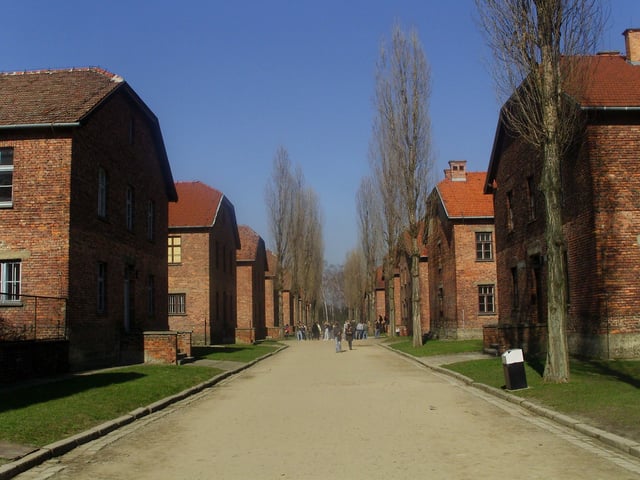
Auschwitz I, 2009
Several SS personnel oversaw the killings at each gas chamber, while the bulk of the work was done by the mostly Jewish prisoners known as Sonderkommandos (special squads).[102][103] Hungarian doctor Miklós Nyiszli reported that the Sonderkommando numbered around 860 prisoners when the Hungarian Jews were being killed in May–July 1944.[104] Their responsibilities included removing goods and corpses from the incoming trains, guiding victims to the dressing rooms and gas chambers, and working in the "Canada" barracks, where the victims' possessions were stored.[105] Housed separately from other prisoners, in somewhat better conditions, their quality of life was further improved by access to the goods taken from murdered prisoners, which they were sometimes able to steal and trade on Auschwitz's black market.[106] Many Sonderkommandos committed suicide in response to the horrors of their work; others were generally shot by the SS in a matter of weeks. New Sonderkommando units were formed from incoming transports. Almost none of the 2,000 prisoners placed in these units survived to the camp's liberation.[107]
Tattoos and triangles
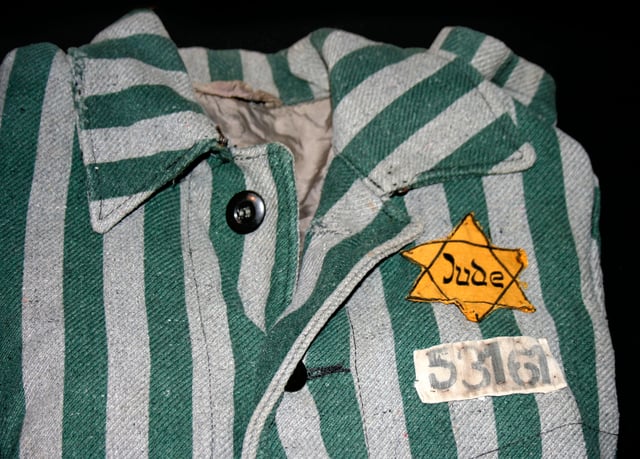
Auschwitz clothing
Uniquely at Auschwitz, prisoners were tattooed with a serial number, on their left breast for Soviet prisoners of war[108] and on the left arm for civilians.[109] Categories of prisoner were distinguishable by triangular pieces of cloth (German: Winkel) sewn onto on their jackets below their prisoner number. Political prisoners (Schutzhäftlinge or Sch), mostly Poles, had a red triangle, while criminals (Berufsverbrecher or BV) were mostly German and wore green. Asocial prisoners (Asoziale or Aso), which included vagrants, prostitutes and the Roma, wore black. Purple was for Jehovah's Witnesses (Internationale Bibelforscher-Vereinigung or IBV)'s and pink for gay men, who were mostly German.[110] An estimated 5,000–15,000 gay men prosecuted under German Penal Code Section 175 (proscribing sexual acts between men) were detained in concentration camps, of whom an unknown number were sent to Auschwitz.[111] Jews wore a yellow badge, the shape of the Star of David, overlaid by a second triangle if they also belonged to a second category. The nationality of the inmate was indicated by a letter stitched onto the cloth. A racial hierarchy existed, with German prisoners at the top. Next were non-Jewish prisoners from other countries. Jewish prisoners were at the bottom.[112]
Transports
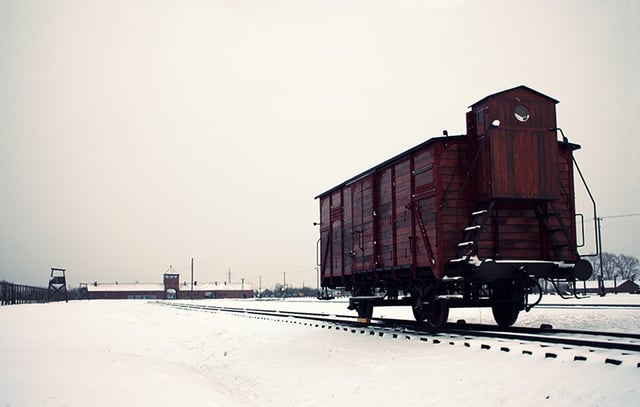
Freight car inside Auschwitz II-Birkenau, near the gatehouse, used to transport deportees, 2014[113]
Deportees were brought to Auschwitz crammed in wretched conditions into goods or cattle wagons, arriving near a railway station or at one of several dedicated trackside ramps, including one next to Auschwitz I. The Altejudenrampe (old Jewish ramp), part of the Oświęcim freight railway station, was used from 1942 to 1944 for Jewish transports.[113][114] Located between Auschwitz I and Auschwitz II, arriving at this ramp meant a 2.5 km journey to Auschwitz II and the gas chambers. Most deportees were forced to walk, accompanied by SS men and a car with a Red Cross symbol that carried the Zyklon B, as well as an SS doctor in case officers were poisoned by mistake. Inmates arriving at night, or who were too weak to walk, were taken by truck.[115] Work on another railway line and Judenrampe (pictured right) between sectors BI and BII in Auschwitz II, was completed in May 1944 for the arrival of Hungarian Jews,[114] who between May and early July 1944 were deported to Auschwitz II at a rate of 12,000 a day.[116] The rails led directly to the area around the gas chambers.[113]
Life for the inmates
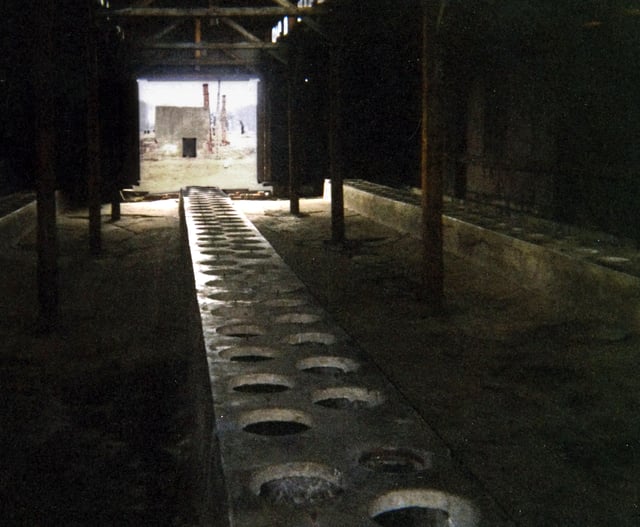
Latrine in the men's quarantine camp, sector BIIa, Auschwitz II, 2003
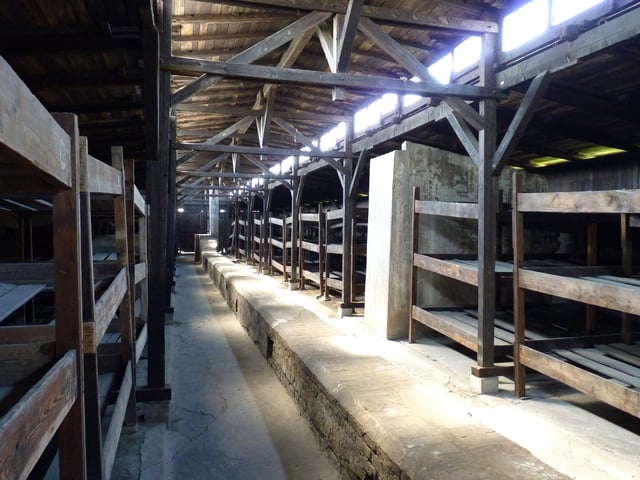
Auschwitz II barracks, 2011
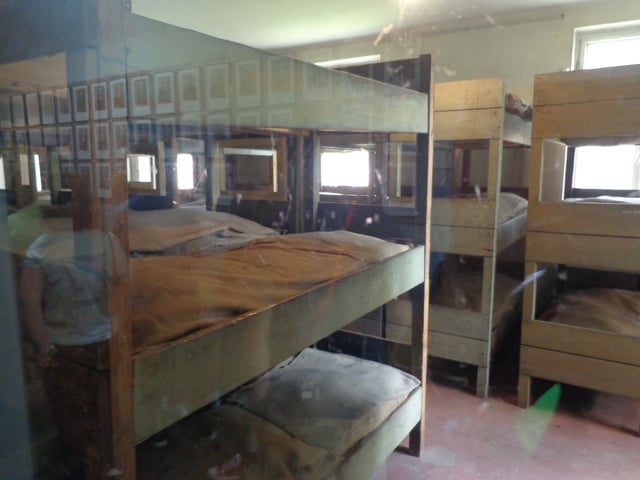
Auschwitz I barracks, 2015

Auschwitz I barracks, 2006
The prisoners' days began at 4:30 am for the men (an hour later in winter), and earlier for the women, when the block supervisor sounded a gong and started beating inmates with sticks to encourage them to wash and use the latrines quickly.[117] Sanitary arrangements were atrocious, with few latrines and a lack of clean water. Each washhouse had to service thousands of prisoners. In sectors BIa and BIb in Auschwitz II-Birkenau, two buildings containing latrines and washrooms were installed in 1943. These contained troughs for washing and 90 faucets; the toilet facilities were "sewage channels" covered by concrete with 58 holes for seating. There were three barracks with washing facilities or toilets to serve 16 residential barracks in BIIa, and six washrooms/latrines for 32 barracks in BIIb, BIIc, BIId, and BIIe.[118] Primo Levi described a 1944 Auschwitz III washroom:
It is badly lighted, full of draughts, with the brick floor covered by a layer of mud. The water is not drinkable; it has a revolting smell and often fails for many hours. The walls are covered by curious didactic frescoes: for example, there is the good Häftling [prisoner], portrayed stripped to the waist, about to diligently soap his sheared and rosy cranium, and the bad Häftling, with a strong Semitic nose and a greenish colour, bundled up in his ostentatiously stained clothes with a beret on his head, who cautiously dips a finger into the water of the washbasin. Under the first is written: "So bist du rein" (like this you are clean), and under the second, "So gehst du ein" (like this you come to a bad end); and lower down, in doubtful French but in Gothic script: "La propreté, c'est la santé" [cleanliness is health].[119]
Prisoners received half a liter of coffee substitute or a herbal "tea" in the morning, but no food.[120] A second gong heralded roll call, when inmates had to line up outside in rows of ten to be counted. No matter how cold the weather, prisoners had to wait for the SS to arrive for the count. How long they stood there depended on the officers' mood, and whether there had been escapes or other events attracting punishment.[121] Guards might force the prisoners to squat for an hour with their hands above their heads, or hand out beatings or detention for infractions such as having a missing button or an improperly cleaned food bowl. The inmates were counted and re-counted.[122]
After roll call, to the sound of "Arbeitskommandos formieren" ("form work details"), prisoners walked to their place of work, five abreast, to begin a working day that was normally 11 hours long—longer in summer and shorter in winter.[123] A prison orchestra, such as the Women's Orchestra of Auschwitz, was forced to play cheerful music as the workers left the camp. Kapos were responsible for the prisoners' behavior while they worked, as was an SS escort. Much of the work took place outdoors at construction sites, gravel pits, and lumber yards. No rest periods were allowed. One prisoner was assigned to the latrines to measure the time the workers took to empty their bladders and bowels.[122][124]
Lunch was three quarters of a liter of watery soup at midday, reportedly foul-tasting, with meat in the soup four times a week and vegetables (mostly potatoes and rutabaga) three times. The evening meal was 300 grams of bread, often moldy, part of which the inmates were expected to keep for breakfast the next day, with a tablespoon of cheese or marmalade, or 25 grams of margarine or sausage. Prisoners engaged in hard labor were given extra rations.[125]
Sunday was not a work day, but prisoners were required to clean the barracks and take their weekly shower,[126] and were allowed to write (in German) to their families, although the SS censored the outgoing mail. Inmates who did not speak German would trade some of their bread for help composing their letters.[127] Observant Jews tried to keep track of the Hebrew calendar and Jewish holidays, including Shabbat, and the weekly Torah portion. No watches, calendars, or clocks were permitted in the camp. Jewish calendars were rare among prisoners; being in possession of one was dangerous. Only two Jewish calendars made in Auschwitz survived to the end of the war. Prisoners kept track of the days in other ways, such as obtaining information from newcomers.[128]
A second roll call took place at seven in the evening after the long day's work.[129] Prisoners might be hanged or flogged in the course of it. If a prisoner was missing, the others had to remain standing until he or she was found or the reason for the absence discovered, even if it took hours. On 6 July 1940, roll call lasted 19 or 20 hours because of the escape of a Polish prisoner, Tadeusz Wiejowski; following another escape in 1941, a group of prisoners was sent to block 11 to be starved to death.[130] After roll call, prisoners were allowed to retire to their blocks for the night and receive their bread rations and water. Curfew was at nine o'clock. Inmates slept in long rows of brick or wooden bunks, lying in and on their clothes and shoes to prevent them from being stolen.[131] The wooden bunks had blankets and paper mattresses filled with wood shavings; in the brick barracks, inmates lay on straw.[132] According to Nyiszli:
Eight hundred to a thousand people were crammed into the superimposed compartments of each barracks. Unable to stretch out completely, they slept there both lengthwise and crosswise, with one man's feet on another's head, neck, or chest. Stripped of all human dignity, they pushed and shoved and bit and kicked each other in an effort to get a few more inches' space on which to sleep a little more comfortably. For they did not have long to sleep.[133]
Women's camp
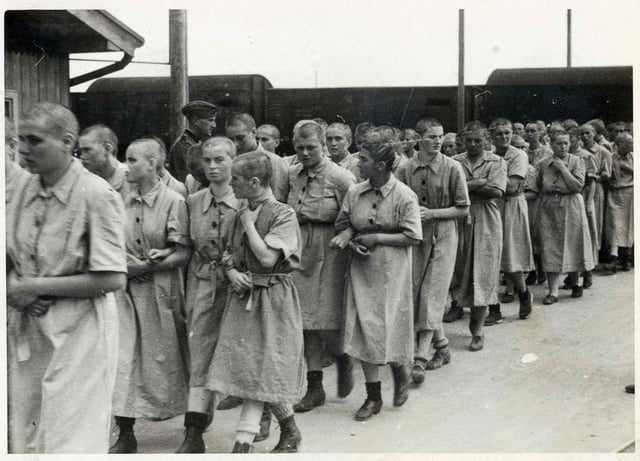
Women in Auschwitz II, May 1944
The women's concentration camp (Frauenkonzentrationslager or FKL) was established in August 1942, in 15 brick and 15 wooden barracks in sector BIa (Bauabschnitt Ia) in Auschwitz II, when 13,000 women were transferred from Auschwitz I. The camp was later extended into sector BIb, and by October 1943 it held 32,066 women. Conditions in the camp were so poor that, in October 1942, when a group of male prisoners arrived to set up an infirmary, their first task, according to researchers from the Auschwitz museum, was to distinguish the corpses from the women who were still alive.[134] Gisella Perl, a Romanian-Jewish gynecologist and inmate of the women's camp, wrote in 1948:
There was one latrine for thirty to thirty-two thousand women and we were permitted to use it only at certain hours of the day. We stood in line to get in to this tiny building, knee-deep in human excrement. As we all suffered from dysentry, we could barely wait until our turn came, and soiled our ragged clothes, which never came off our bodies, thus adding to the horror of our existence by the terrible smell that surrounded us like a cloud. The latrine consisted of a deep ditch with planks thrown across it at certain intervals. We squatted on those planks like birds perched on a telegraph wire, so close together that we could not help soiling one another.[135]
SS-Oberaufseherin Maria Mandl was the commandant of the women's camp until July 1943, followed by SS-Hauptsturmfuhrer Franz Hössler. Both were executed after the war. Sterilization experiments were carried out in barracks 30 by a German gynecologist, Carl Clauberg, and another German doctor, Horst Schumann.[134]
Medical experiments, block 10
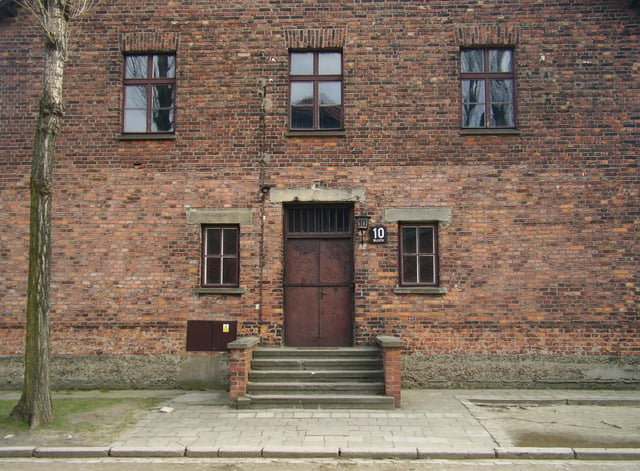
Block 10, Auschwitz I, where medical experiments were performed on women
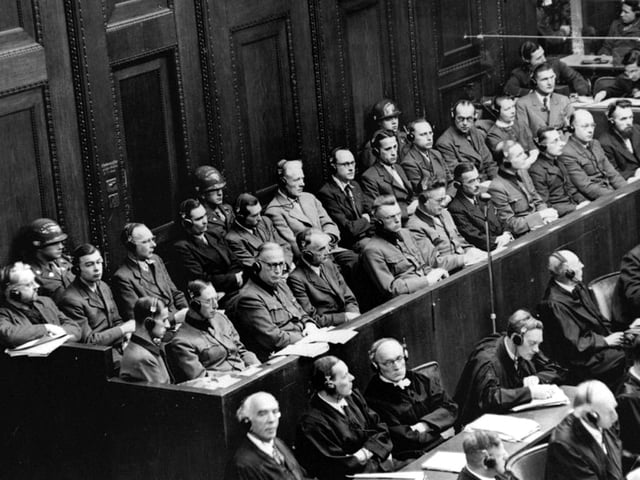
Defendants during the Doctors' trial, Nuremberg, 1946–1947
German doctors performed a variety of experiments on prisoners at Auschwitz. SS doctors tested the efficacy of X-rays as a sterilization device by administering large doses to female prisoners. Carl Clauberg injected chemicals into women's uteruses in an effort to glue them shut. Prisoners were infected with spotted fever for vaccination research and exposed to toxic substances to study the effects.[136] In one experiment Bayer, then part of IG Farben, paid RM 150 each for 150 female inmates from Auschwitz (the camp had asked for RM 200 per woman), who were transferred to a Bayer facility to test an anesthetic. A Bayer employee wrote to Rudolf Höss: "The transport of 150 women arrived in good condition. However, we were unable to obtain conclusive results because they died during the experiments. We would kindly request that you send us another group of women to the same number and at the same price." The Bayer research was led at Auschwitz by Helmuth Vetter of Bayer/IG Farben, who was also an Auschwitz physician and SS captain, and by Auschwitz physicians Friedrich Entress and Eduard Wirths.[137]
The most infamous doctor at Auschwitz was Josef Mengele, the "Angel of Death", who worked in Auschwitz II from 30 May 1943, at first in the gypsy family camp.[138] Particularly interested in performing research on identical twins, dwarfs, and those with hereditary disease, Mengele set up a kindergarten in barracks 29 and 31 for children he was experimenting on, and for all Romani children under six, where they were given better food rations.[139] From May 1944, he would select twins and dwarfs during selection on the Judenrampe,[140] reportedly calling for twins with "Zwillinge heraus!" ("twins step forward!").[141] He and other doctors (the latter prisoners) would measure the twins' body parts, photograph them, and subject them to dental, sight and hearing tests, x-rays, blood tests, surgery, and blood transfusions between them.[142] Then he would have them killed and dissected.[140] Kurt Heissmeyer, another German doctor and SS officer, took 20 Jewish children from Auschwitz to use in pseudoscientific medical experiments at the Neuengamme concentration camp.[143] In April 1945, the children were killed by hanging to conceal the project.[144]
A Jewish skeleton collection was obtained from among a pool of 115 Jewish Auschwitz inmates, chosen for their perceived stereotypical racial characteristics.[3] Rudolf Brandt and Wolfram Sievers, general manager of the Ahnenerbe (a Nazi research institute), delivered the skeletons to the collection of the Anatomy Institute at the Reichsuniversität Straßburg in Occupied France. The collection was sanctioned by Himmler and under the direction of August Hirt. Ultimately 87 of the inmates were shipped to Natzweiler-Struthof and killed in August 1943.[146] Brandt and Sievers were executed in 1948 after being convicted during the Doctors' trial, part of the Subsequent Nuremberg trials.[147]
Block 11
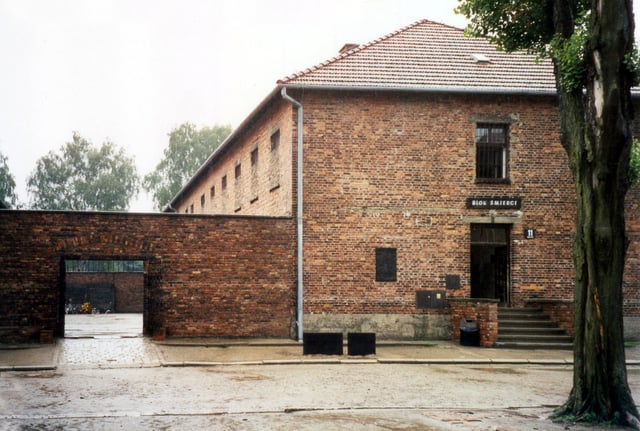
Block 11 and (left) the "death wall", Auschwitz I, 2000
Known as block 13 until 1941, block 11 of Auschwitz I was the prison within the prison, where violators of the numerous rules were punished. To extract information from them, guards would hold inmates' heads against the stove, burning their faces and eyes. Some prisoners were made to spend the nights in standing cells. Measuring 1.5 m2 (16 sq ft), the cells held four men who could do nothing but stand, and who were forced the following day to work as usual.[148] In other cells, inmates were subjected to hanging with their hands behind their backs, thus dislocating their shoulder joints. In the basement were the "dark cells", which had only a 5 x 5 cm opening and a solid door. Prisoners placed in these cells gradually suffocated as they ran out of oxygen; sometimes the SS lit a candle in the cell to use up the oxygen more quickly.[149]
The courtyard between blocks 10 and 11, known as the "death wall" served as an execution area for Poles not in Auschwitz who had been sentenced to death by a criminal court—presided over by German judges—including for petty crimes such as stealing food.[150] Several rooms in block 11 were deemed the Polizei-Ersatz-Gefängnis Myslowitz in Auschwitz ("Alternative jail of the police station at Mysłowice").[151] There were also Sonderbehandlung cases ("special treatment") for Poles and others regarded as dangerous to the Third Reich.[152] Members of the camp resistance were shot there, as were 200 of the Sonderkommandos who took part in the Sonderkommando revolt in October 1944.[153] Thousands of Poles were executed at the death wall; Höss wrote that "execution orders arrived in an unbroken stream".[154]
Gypsy family camp
A separate camp for the Roma, the Zigeunerfamilienlager ("Gypsy family camp"), was set up in the BIIe sector of Auschwitz II-Birkenau in February 1943. For unknown reasons, they were not subject to selection and families were allowed to stay together. The first transport of German Roma arrived at Auschwitz II on 26 February that year. There had been a small number of Romani inmates before that; two Czech Romani prisoners, Ignatz and Frank Denhel, tried to escape in December 1942, the latter successfully, and a Polish Romani woman, Stefania Ciuron, arrived on 12 February 1943 and escaped in April.[156]
The Auschwitz registry (Hauptbücher) shows that 20,946 Roma were registered prisoners,[157] and another 3,000 are thought to have entered unregistered.[158] On 22 March 1943, one transport of 1,700 Polish Sinti and Roma was gassed on arrival because of illness, as was a second group of 1,035 on 25 May 1943.[157] The SS tried to liquidate the camp on 16 May 1944, but the Roma fought them, armed with knives and iron pipes, and the SS retreated. Shortly after this, the SS removed nearly 2,908 from the family camp to work, and on 2 August 1944 gassed the other 2,897. Ten thousand remain unaccounted for.[159]
Theresienstadt family camp
The Theresienstadt family camp, which existed between September 1943 and July 1944, served a different purpose. A group of around 5,000 Jews had arrived in Auschwitz in September 1943 from the Theresienstadt ghetto in Czechoslovakia. The families were allowed to stay together, their heads were not shaved, and they could wear their own clothes. Correspondence between Adolf Eichmann's office and the International Red Cross suggests that the Germans set up the camp to cast doubt on reports, in time for a planned Red Cross visit to Auschwitz, that mass murder was taking place in Auschwitz. A second group of 5,000 arrived from Theresienstadt in December 1943. On 7 March 1944, the first group was sent to the gas chamber at crematorium III; before they died, they were asked to send postcards to relatives, postdated to 25 March.[160] This was the largest massacre of Czechoslovak citizens in history. News of the liquidation reached the Czechoslovak government-in-exile, which initiated diplomatic manoeuvers to save the remaining Jews. After the Red Cross visited Theresienstadt in June 1944 and were persuaded by the SS that no deportations were taking place from there, about 3,500 Jews were removed from the family camp to other sections of Auschwitz. The remaining 6,500 were murdered in the gas chambers between 10 and 12 July 1944.[161][162]
Selection and extermination process
Gas chambers
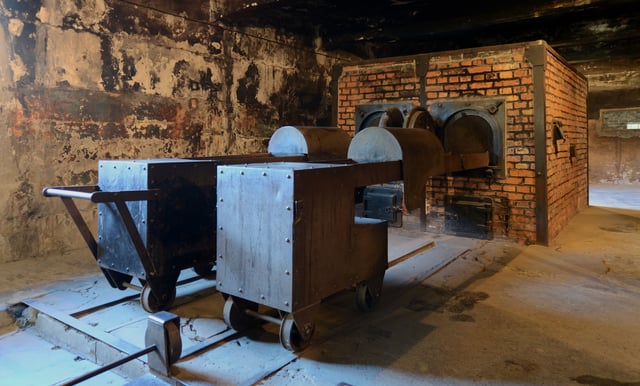
A reconstruction of crematorium I, Auschwitz I, 2014[163]
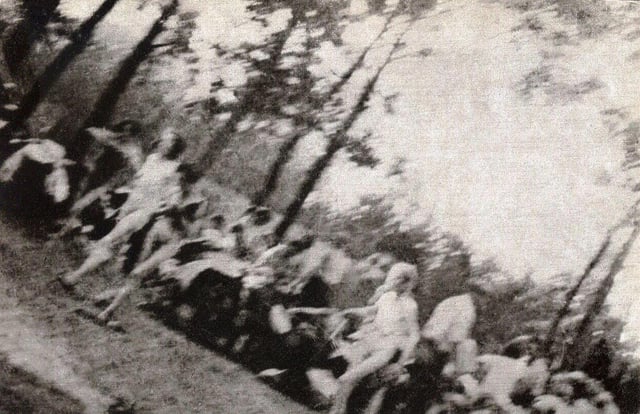
Women on their way to the gas chamber, Auschwitz II, August 1944 (one of the Sonderkommando photographs)

Jewish women and children from Subcarpathian Rus walking toward the gas chamber, Auschwitz II, May/June 1944. The gate on the left leads to sector BI, the oldest part of the camp.[168]

Hungarian Jews from the Tét ghetto arriving at Auschwitz II, May/June 1944
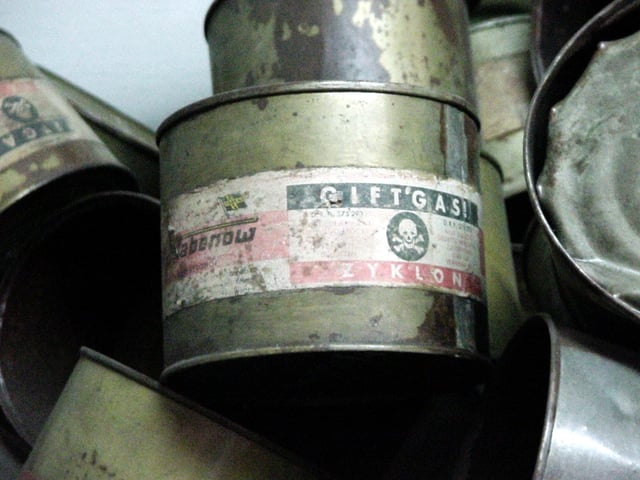
Zyklon B container, Auschwitz Museum
On 31 July 1941, Hermann Göring gave written authorization to Reinhard Heydrich, Chief of the Reich Security Head Office (RSHA), to prepare and submit a plan for Die Endlösung der Judenfrage (the Final Solution of the Jewish question) in territories under German control and to coordinate the participation of all involved government organizations.[164] Plans for the extermination of the European Jews—eleven million people—were formalized at the Wannsee Conference in Berlin on 20 January 1942. Some would be worked to death and the rest killed.[165] Initially the victims were killed with gas vans or by Einsatzgruppen firing squads, but these methods were impractical for an operation of this scale.[166] By 1942, killing centers at Auschwitz, Sobibór, Treblinka, and other extermination camps had become the primary method of mass killing.[167]
The first gassings at Auschwitz took place in early September 1941, when around 850 inmates—Soviet prisoners of war and sick Polish inmates—were killed with Zyklon B in the basement of block 11 in Auschwitz I. The building proved unsuitable, so gassings were conducted instead in crematorium I, also in at Auschwitz I, which operated until December 1942. There, more than 700 victims could be killed at once.[169] Tens of thousands were killed in crematorium I.[42] To keep the victims calm, they were told they were to undergo disinfection and de-lousing; they were ordered to undress outside, then were locked in the building and gassed. After its decommissioning as a gas chamber, the building was converted to a storage facility and later served as an SS air raid shelter.[170] The gas chamber and crematorium were reconstructed after the war. Dwork and van Pelt write that a chimney was recreated; four openings in the roof were installed to show where the Zyklon B had entered; and two of the three furnaces were rebuilt with the original components.[171]
In early 1942, mass exterminations were moved to two provisional gas chambers (the "red house" and "white house", known as bunkers 1 and 2) in Auschwitz II, while the larger crematoria (II, III, IV, and V) were under construction. Bunker 2 was temporarily reactivated from May to November 1944, when large numbers of Hungarian Jews were gassed.[172] In summer 1944 the combined capacity of the crematoria and outdoor incineration pits was 20,000 bodies per day.[173] A planned sixth facility—crematorium VI—was never built.[174] Prisoners were transported from all over German-occupied Europe by rail, arriving in daily convoys.[175] By July 1942, the SS were conducting "selections". Incoming Jews were segregated; those deemed able to work were sent to the selection officer's right and admitted into the camp, and those deemed unfit for labor were sent to the left and immediately gassed.[176] The group selected to die, about three-quarters of the total,[4] included almost all children, women with small children, the elderly, and all those who appeared on brief and superficial inspection by an SS doctor not to be fit for work.[178]
After the selection process was complete, those too ill or too young to walk to the crematoria were transported there on trucks or killed on the spot with a bullet to the head.[179][180] The belongings of the arrivals were seized by the SS and sorted in an area of the camp called "Canada", so called because Canada was seen as a land of plenty. Many of the SS at the camp enriched themselves by pilfering the confiscated property.[181]
The crematoria consisted of a dressing room, gas chamber, and furnace room. In crematoria II and III, the dressing room and gas chamber were underground; in IV and V, they were on the ground floor. The dressing room had numbered hooks on the wall to hang clothes. In crematorium II, there was also a dissection room (Sezierraum).[182] SS officers told the victims they were to take a shower and undergo delousing. The victims undressed in the dressing room and walked into the gas chamber, which was disguised as a shower facility; signs in German said "To the baths" and "To disinfection". Some inmates were even given soap and a towel.[183]
The Zyklon B was delivered by ambulance to the crematoria by a special SS bureau known as the Hygienic Institute.[115] The actual delivery of the gas to the victims was always handled by the SS, on the order of the supervising SS doctor.[184][185] After the doors were shut, SS men dumped in the Zyklon B pellets through vents in the roof or holes in the side of the chamber. The victims were dead within 20 minutes.[184] Despite the thick concrete walls, screaming and moaning from within could be heard outside. In one failed attempt to muffle the noise, two motorcycle engines were revved up to full throttle nearby, but the sound of yelling could still be heard over the engines.[186]
Sonderkommando wearing gas masks then dragged the bodies from the chamber. The victims' glasses, artificial limbs, jewelry, and hair were removed, and any dental work was extracted so the gold could be melted down.[187] The corpses were burned in the nearby incinerators, and the ashes were buried, thrown in the river, or used as fertilizer.[187]
The gas chambers worked to their fullest capacity from April to July 1944, during the massacre of Hungary's Jews. Hungary was an ally of Germany during the war, but it had resisted turning over its Jews until Germany invaded that March.[188] A rail spur leading to crematoria II and III in Auschwitz II was completed that May, and a new ramp was built between sectors BI and BII to deliver the victims closer to the gas chambers.[189] On 29 April the first 1,800 Hungarian Jews arrived at the camp;[189] from 14 May until early July 1944, 437,000 Hungarian Jews, half the pre-war population, were deported to Auschwitz, at a rate of 12,000 a day for a considerable part of that period.[116] The crematoria had to be overhauled. Crematoria II and III were given new elevators leading from the stoves to the gas chambers, new grates were fitted, and several of the dressing rooms and gas chambers were painted. Cremation pits were dug behind crematorium V.[189] The last mass transports to arrive in Auschwitz were 60,000–70,000 Jews from the Łódź Ghetto, some 2,000 from Theresienstadt, and 8,000 from Slovakia.[177][190] The last selection took place on 30 October 1944.[173] Crematorium IV was demolished after the Sonderkommando revolt on 7 October 1944. The SS blew up crematorium V on 14 January 1945, and crematoria II and III on 20 January.[191]
Death toll
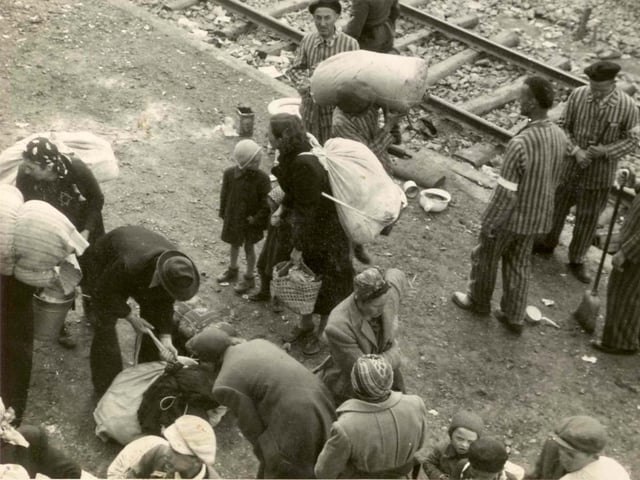
At the Judenrampe, Auschwitz II-Birkenau, May or June 1944
Overall 268,657 male and 131,560 female prisoners were registered in Auschwitz, 400,207 in total.[192] Many prisoners were never registered and much evidence was destroyed by the SS in the final days of the war, making the number of victims hard to ascertain.[193] Himmler visited the camp on 17 July 1942 and watched a gassing; a few days later, according to Höss's post-war memoir, Höss received an order from Himmler, via Adolf Eichmann's office and SS commander Paul Blobel, that "[a]ll mass graves were to be opened and the corpses burned. In addition the ashes were to be disposed of in such a way that it would be impossible at some future time to calculate the number of corpses burned."[194]
Following the camp's liberation, the Soviet government issued a statement, on 8 May 1945, that four million people had been killed on the site, a figure based on the capacity of the crematoria and later regarded as too high.[195] Höss told prosecutors at Nuremberg that at least 2,500,000 people had been murdered in Auschwitz by gassing and burning, and that another 500,000 had died of starvation and disease.[196] He testified that the figure of over two million had come from Eichmann.[197][5] In his memoirs, written in custody, he wrote that he regarded this figure as "far too high. Even Auschwitz had limits to its destructive possibilities."[199] Raul Hilberg's 1961 work, The Destruction of the European Jews, estimated that up to 1,000,000 Jews had died in Auschwitz.[200]
In 1983, French scholar George Wellers was one of the first to use German data on deportations; he arrived at a figure of 1,471,595 deaths, including 1.35 million Jews and 86,675 Poles.[201] A larger study in the late 1980s by Franciszek Piper, published by Yad Vashem in 1991,[202] used timetables of train arrivals combined with deportation records to calculate that, of the 1.3 million deported to the camp, 1,082,000 died there between 1940 and 1945, a figure (rounded up to 1.1 million) that he regarded as a minimum[203] and that came to be widely accepted.[6]
| Nationality/ethnicity (Source: Franciszek Piper)[205] | Registered deaths (Auschwitz) | Unregistered deaths (Auschwitz) | Total |
|---|---|---|---|
| Jews | 95,000 | 865,000 | 960,000 |
| Ethnic Poles | 64,000 | 10,000 | 74,000 (70,000–75,000) |
| Roma and Sinti | 19,000 | 2,000 | 21,000 |
| Soviet prisoners of war | 12,000 | 3,000 | 15,000 |
| Other Europeans: Soviet citizens (Byelorussians, Russians, Ukrainians), Czechs, Yugoslavs, French, Germans, Austrians | 10,000–15,000 | n/a | 10,000–15,000 |
| Total deaths in Auschwitz, 1940–1945 | 200,000–205,000 | 880,000 | 1,080,000–1,085,000 |
Around one in six Jews killed in the Holocaust died in Auschwitz.[206] By nation, the greatest number of Auschwitz's Jewish victims originated from Hungary, accounting for 430,000 deaths, followed by Poland (300,000), France (69,000), Netherlands (60,000), Greece (55,000), Protectorate of Bohemia and Moravia (46,000), other camps (34,000), Slovakia (27,000), Belgium (25,000), Germany and Austria (23,000), Yugoslavia (10,000), Italy (7,500), and Norway (690).[16] Fewer than one percent of Soviet Jews murdered in the Holocaust were killed in Auschwitz; German forces had already been driven from Russia when the killing at Auschwitz reached its peak in 1944.[207] Of the 400 Jehovah's Witnesses who were imprisoned at Auschwitz, 132 died there.[208]
Resistance, escapes, liberation
Camp resistance, flow of information
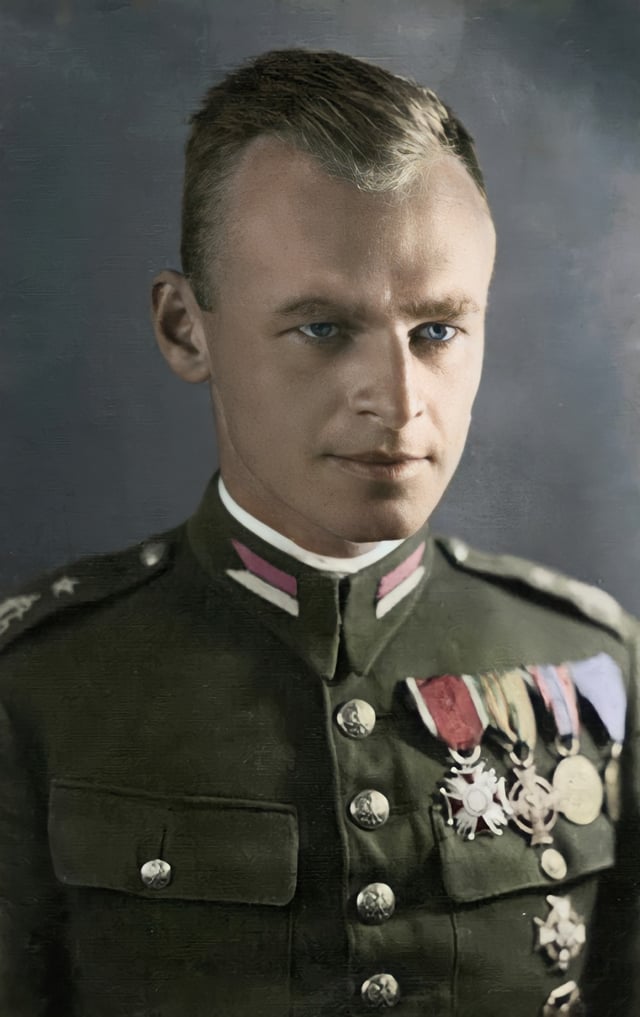
Captain Witold Pilecki
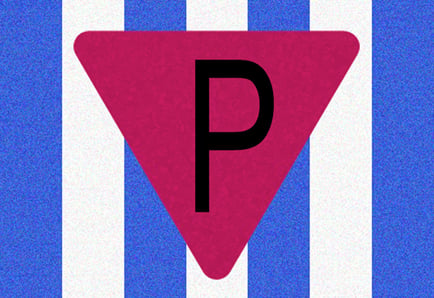
The camp badge for non-Jewish Polish political prisoners
Information about Auschwitz became available to the Allies as a result of reports by Captain Witold Pilecki of the Polish Home Army (Armia Krajowa), who volunteered to be imprisoned there in 1940. As "Thomasz Serfiński", he allowed himself to be arrested in Warsaw and spent 945 days in the camp, from 22 September 1940[210] until his escape on 27 April 1943. Michael Fleming writes that Pilecki was instructed to sustain morale, organize food, clothing and resistance, prepare to take over the camp if possible, and smuggle information out to the Polish military.[211] Pilecki called his resistance movement Związek Organizacji Wojskowej (ZOW, "Union of Military Organization").[210]
The resistance sent out the first oral message about Auschwitz with Dr. Aleksander Wielkopolski, a Polish engineer who was released in October 1940.[212] The following month the Polish underground in Warsaw prepared a report on the basis of that information, The camp in Auschwitz, part of which was published in London in May 1941 in a booklet, The German Occupation of Poland, by the Polish Ministry of Foreign Affairs. The report said of the Jews in the camp that "scarcely any of them came out alive". According to Fleming, the booklet was "widely circulated amongst British officials". The Polish Fortnightly Review based a story on it, writing that "three crematorium furnaces were insufficient to cope with the bodies being cremated", as did The Scotsman on 8 January 1942, the only British news organization to do so.[213]
On 24 December 1941 the resistance groups representing the various prisoner factions met in block 45 and agreed to cooperate. Fleming writes that it has not been possible to track Pilecki's early intelligence from the camp. Pilecki compiled two reports after he escaped in April 1943; the second, Raport W, detailed his life in Auschwitz I and estimated that 1.5 million people, mostly Jews, had been killed.[214] On 1 July 1942, the Polish Fortnightly Review published a report describing Birkenau, writing that "prisoners call this supplementary camp 'Paradisal', presumably because there is only one road, leading to Paradise". Reporting that inmates were being killed "through excessive work, torture and medical means", it noted the gassing of the Soviet prisoners of war and Polish inmates in Auschwitz I in September 1941, the first gassing in the camp. It said: "It is estimated that the Oswiecim camp can accommodate fifteen thousand prisoners, but as they die on a mass scale there is always room for new arrivals."[215]
From 1942, members of the Bureau of Information and Propaganda of the Warsaw-area Home Army published reports based on the accounts of escapees. The first was a fictional memoir, "Oświęcim. Pamiętnik więźnia" ("Auschwitz: Diary of a prisoner") by Halina Krahelska, published in April 1942 in Warsaw.[216] Also published in 1942 was the pamphlet Obóz śmierci (Camp of Death) by Natalia Zarembina,[217] and W piekle (In Hell) by Zofia Kossak-Szczucka, founder of Żegota.[218] In March 1944, the Polish Labor Group in New York published a report in English, "Oswiecim, Camp of Death (Underground Report)", with a foreword by Florence Jaffray Harriman, which described the gassing of prisoners from 1942.[219]
The Polish government-in-exile in London first reported the gassing of prisoners in Auschwitz on 21 July 1942,[220] and reported the gassing of Soviet POWs and Jews on 4 September 1942.[221] In 1943, the Kampfgruppe Auschwitz (Combat Group Auschwitz) was organized within the camp with the aim of sending out information about what was happening.[222] Sonderkommandos buried notes in the ground, hoping they would be found by the camp's liberators.[223] The group also smuggled out photographs; the Sonderkommando photographs, of events around the gas chambers in Auschwitz II, were smuggled out of the camp in September 1944 in a toothpaste tube.[224] According to Fleming, the British press responded, in 1943 and the first half of 1944, either by not publishing reports about Auschwitz or by burying them on the inside pages. The exception was the Polish Jewish Observer, published as a supplement to the City and East London Observer and edited by Joel Cang, a former Warsaw correspondent for the Manchester Guardian. The British reticence stemmed from a Foreign Office concern that the public might pressure the government to respond or provide refuge for the Jews, and that British actions on behalf of the Jews might affect its relationships in the Middle East. There was similar reticence in the United States, and indeed within the Polish government-in-exile and the Polish resistance. According to Fleming, the scholarship suggests that the Polish resistance distributed information about the Holocaust in Auschwitz without challenging the Allies' reluctance to highlight it.[225]
Escapes, Auschwitz Protocols
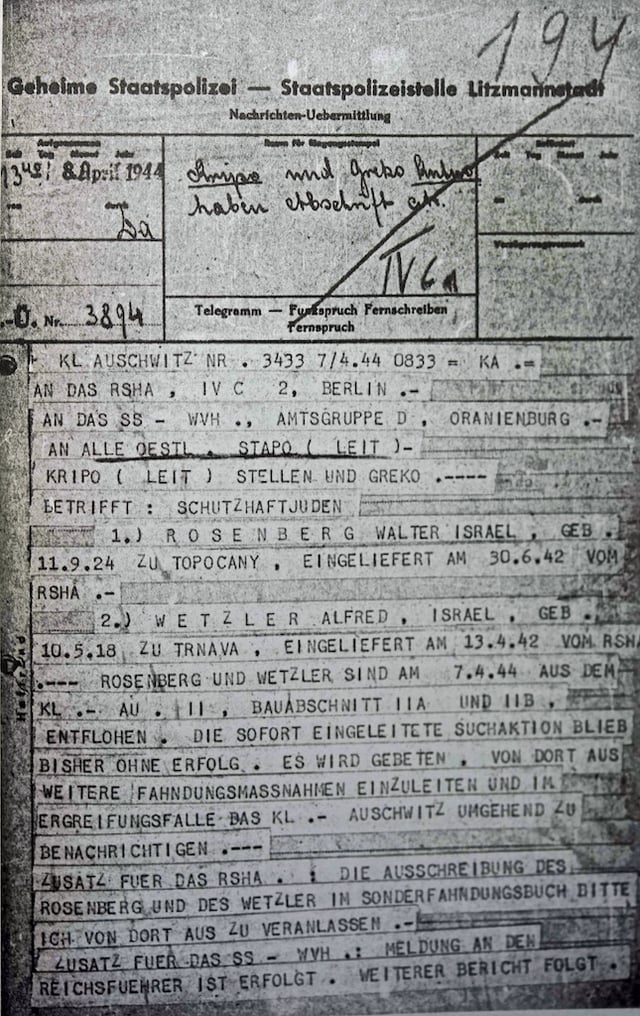
Telegram from KL Auschwitz reporting the escape of Rudolf Vrba and Alfréd Wetzler
From the first escape on 6 July 1940 of Tadeusz Wiejowski,[226] at least 802 prisoners (757 men and 45 women) tried to escape from the camp, according to Polish historian Henryk Świebocki. He writes that most escapes were attempted from work sites outside the camp.[227][7] Of these, 144 were successful and the fate of 331 is unknown.[228] Four Polish prisoners—Eugeniusz Bendera (a car mechanic at the camp), Kazimierz Piechowski, Stanisław Gustaw Jaster, and a priest, Józef Lempart—escaped successfully on 20 June 1942.[229] After breaking into a warehouse, the four dressed as members of the SS-Totenkopfverbände (the SS units responsible for concentration camps), armed themselves, and stole an SS staff car, which they drove unchallenged through the main gate, greeting several officers with "Heil Hitler!" as they drove past.[230] On 21 July 1944, Polish inmate Jerzy Bielecki dressed in an SS uniform and, using a faked pass, managed to cross the camp's gate with his Jewish girlfriend, Cyla Cybulska (known as Cyla Stawiska), pretending that she was wanted for questioning. Both survived the war. For having saved her, Bielecki was recognized by Yad Vashem as Righteous Among the Nations.[231]
Jerzy Tabeau (prisoner no. 27273, registered as Jerzy Wesołowski) and Roman Cieliczko (no. 27089), both Polish prisoners, escaped on 19 November 1943; Tabeau made contact with the Polish underground and, between December 1943 and early 1944, wrote what became known as the Polish Major's report about the situation in the camp.[232] On 27 April 1944, Rudolf Vrba (no. 44070) and Alfréd Wetzler (no. 29162) escaped to Slovakia, carrying detailed information to the Slovak Jewish Council about the gas chambers. The distribution of the Vrba-Wetzler report, and publication of parts of it in June 1944, helped to halt the deportation of Hungarian Jews to Auschwitz. On 27 May 1944, Arnost Rosin (no. 29858) and Czesław Mordowicz (no. 84216) also escaped to Slovakia; the Rosin-Mordowicz report was added to the Vrba-Wetzler and Tabeau reports to become what is known as the Auschwitz Protocols.[233] The reports were first published in their entirety in November 1944 by the United States War Refugee Board, in a document entitled The Extermination Camps of Auschwitz (Oświęcim) and Birkenau in Upper Silesia.[234]
Bombing proposal
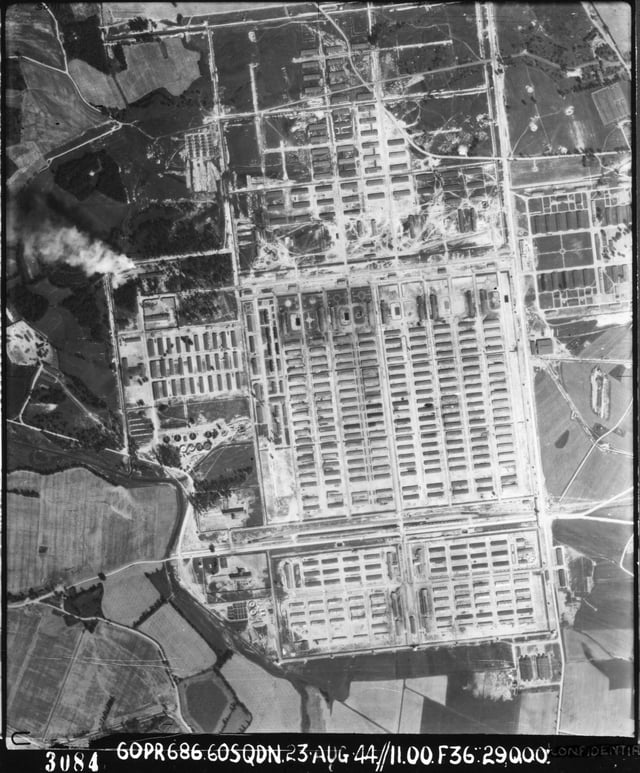
Aerial view of Auschwitz II-Birkenau taken by the RAF on 23 August 1944
Slovak rabbi Michael Dov Weissmandl was the first to suggest, in May 1944, that the Allies bomb the rails leading to Auschwitz.[235] At one point British Prime Minister Winston Churchill ordered that such a plan be prepared, but he was told that precision bombing the camp to free the prisoners or disrupt the railway was not technically feasible.[236] In 1978, historian David Wyman published an essay in Commentary entitled "Why Auschwitz Was Never Bombed", arguing that the United States Army Air Forces had the capability to attack Auschwitz and should have done so; he expanded his arguments in his book The Abandonment of the Jews: America and the Holocaust 1941–1945 (1984). Wyman argued that, since the IG Farben plant at Auschwitz III had been bombed three times between August and December 1944 by the US Fifteenth Air Force in Italy, it would have been feasible for the other camps or railway lines to be bombed too. Bernard Wasserstein's Britain and the Jews of Europe (1979) and Martin Gilbert's Auschwitz and the Allies (1981) raised similar questions about British inaction.[237] Since the 1990s, other historians have argued that Allied bombing accuracy was not sufficient for Wyman's proposed attack, and that counterfactual history is an inherently problematic endeavor.[238]
Sonderkommando revolt
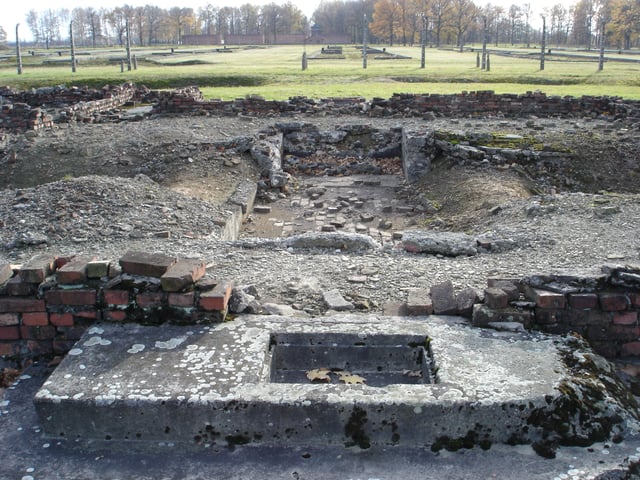
Ruins of Crematorium IV, Auschwitz II, blown up during the revolt
Aware that as witnesses to the killings they would eventually be killed themselves, the Sonderkommandos of Birkenau Kommando III staged an uprising on 7 October 1944, following an announcement that some of them would be selected to be "transferred to another camp"—a common Nazi ruse for the murder of prisoners.[239][240] They attacked the SS guards with stones, axes, and makeshift hand grenades, which they also used to damage Crematorium IV and set it on fire. As the SS set up machine guns to attack the prisoners in Crematorium IV, the Sonderkommandos in Crematorium II also revolted, some of them managing to escape the compound.[240][241] The rebellion was suppressed by nightfall.[242]
Ultimately, three SS guards were killed—one of whom was burned alive by the prisoners in the oven of Crematorium II[241]—and 451 Sonderkommandos were killed.[243][244] Hundreds of prisoners escaped, but all were soon captured and executed, along with an additional group who had participated in the revolt.[241] Crematorium IV was destroyed in the fighting. A group of prisoners in the gas chamber of Crematorium V was spared in the chaos.[242][241]
Evacuation and death marches
According to Polish historian Andrzej Strzelecki, the evacuation of the prisoners by the SS in January 1945 was one of the camp's "most tragic chapters".[245] In mid-1944, about 130,000 prisoners were in Auschwitz when the SS moved around half of them to other concentration camps.[246] In November 1944, with the Soviet Red Army approaching through Poland, Himmler ordered gassing operations to cease. The crematorium IV building was dismantled,[247] and the Sonderkommando was ordered to remove evidence of the killings, including the mass graves.[248] The SS destroyed written records, and in the final week before the camp's liberation, burned or demolished many of its buildings.[249] The plundered goods from the "Canada" barracks at Birkenau, together with building supplies, were transported to the German interior. On 20 January, the overflowing warehouses were set ablaze. Crematoria II and III at Birkenau were blown up on 20 January and crematorium V six days later, just one day ahead of the Soviet attack.[247]
That month, Himmler ordered the evacuation of all camps, charging camp commanders with "making sure that not a single prisoner from the concentration camps falls alive into the hands of the enemy".[250] Beginning on 17 January, 56,000–58,000 Auschwitz detainees—over 20,000 from Auschwitz I and II, over 30,000 from subcamps, and two-thirds of them Jews—were evacuated under guard, largely on foot, in severe winter conditions, heading west.[251][252] Around 2,200 were evacuated by rail from two subcamps; fewer than 9,000 were left behind, deemed too sick to move.[253] During the marches, camp staff shot anyone too sick or exhausted to continue, or anyone stopping to urinate or tie a shoelace. SS officers walked behind the marchers killing anyone lagging behind who had not already been shot.[245] Peter Longerich estimates that a quarter of the detainees were thus killed.[246] Those who managed to walk to Wodzisław Śląski and Gliwice were sent on open freight cars, without food, to concentration camps in Germany: Bergen-Belsen, Buchenwald, Dachau, Flossenburg, Gross-Rosen, Mauthausen, Dora-Mittelbau, Ravensbruck, and Sachsenhausen.[254]
A column of inmates reached the Gross-Rosen complex. Throughout February, the terribly overcrowded main camp at Gross-Rosen was cleared, and all 44,000 inmates were moved further west. An unknown number died in this last journey.[255] In March 1945, Himmler ordered that no more prisoners should be killed, as he hoped to use them as hostages in negotiations with the Allies.[256] Approximately 20,000 Auschwitz prisoners made it to Bergen-Belsen, where they were liberated by the British in April 1945.[257]
Liberation
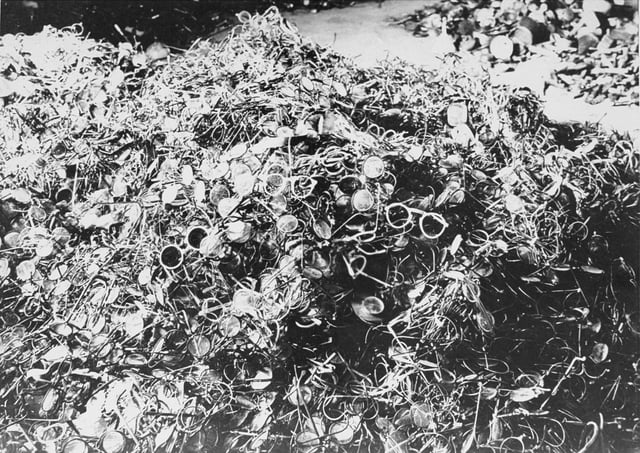
Eyeglasses of victims, 1945
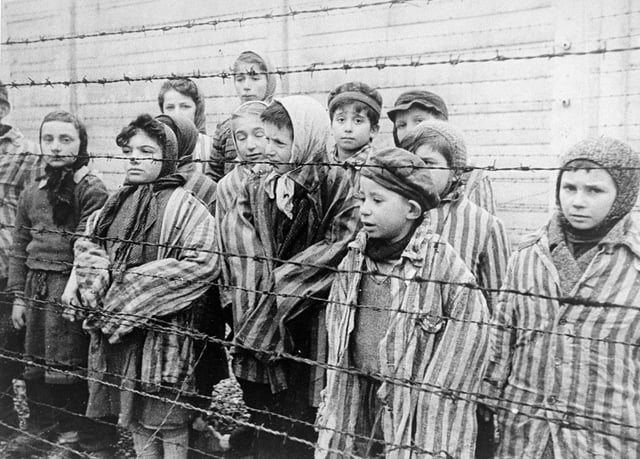
Young survivors at the camp, liberated by the Red Army in January 1945
When the 322nd Rifle Division of the Red Army liberated Auschwitz on 27 January 1945, the soldiers found 7,500 prisoners alive and over 600 corpses.[258][259] There were 700 liberated children (over 500 under age of 15).[260] Auschwitz II-Birkenau was liberated at around 3:30 p.m., and the main camp (Auschwitz I) two hours later.[261] Items found by the Soviet soldiers included 370,000 men's suits, 837,000 women's garments, and 7.7 tonnes (8.5 short tons) of human hair.[258][259] Primo Levi described seeing the first four Russian soldiers on horseback approach the camp at Monowitz, where he had been in the sick bay. The soldiers threw "strangely embarrassed glances at the sprawling bodies, at the battered huts and at us few still alive ...":[262]
They did not greet us, nor did they smile; they seemed oppressed not only by compassion but by a confused restraint, which sealed their lips and bound their eyes to the funereal scene. It was that shame we knew so well, the shame that drowned us after the selections, and every time we had to watch, or submit to, some outrage: the shame the Germans did not know, that the just man experiences at another man's crime; the feeling of guilt that such a crime should exist, that it should have been introduced irrevocably into the world of things that exist, and that his will for good should have proved too weak or null, and should not have availed in defence.[263]
Military trucks loaded with bread arrived on 28 January, and volunteers began to offer first aid and improvised assistance the following week.[261] The liberation of the camp received little Western press attention at the time. Laurence Rees attributes this to three factors: the previous discovery of similar crimes at the Majdanek concentration camp, competing news from the Allied summit at Yalta, and the Soviet Union's Marxist presentation of the camp "as the ultimate capitalist factory where the workers were dispensible", combined with its interest in minimizing attention to Jewish suffering.[264]
In early February, the Polish Red Cross hospital opened in blocks 14, 21, and 22 at Auschwitz I, headed by Dr. Józef Bellert and staffed by 30 volunteer doctors and nurses from Kraków, along with around 90 former inmates. The critically injured patients—estimated at several thousands—were relocated from Birkenau and Monowitz to the main camp. Some orphaned children were adopted by Oświęcim residents, while others were transferred to Kraków, where several were adopted by Polish families, or placed in an orphanage at Harbutowice.[265] The hospital cared for more than 4,500 patients (most of them Jews) from 20 countries, suffering from starvation, alimentary dystrophy, gangrene, necrosis, internal haemorrhaging, and typhoid fever. At least 500 died. Assistance was provided by volunteers from Oświęcim and Brzeszcze, who donated money and food, cleaned hospital rooms, delivered water, washed patients, cooked meals, buried the dead, and transported the sick in horse-drawn carts between locations. Securing enough food for thousands of former prisoners was a constant challenge. The hospital director personally went from village to village to collect milk.[265]
In June 1945 the Soviet authorities took over Auschwitz I and converted it into a POW camp for German prisoners. The hospital had to move beyond the camp perimeter into former administrative buildings, where it functioned until October 1945.[265] Many of the barracks at Birkenau were taken apart by civilians, who used the materials to rebuild their own homes, which had been levelled out in the construction of Auschwitz II. The poorest residents sifted the crematoria ashes in search of nuggets from melted gold, before warning shots were fired.[266] The POW camp for German prisoners of war was used until 1947 by the Soviet NKVD (People's Commissariat for Internal Affairs).[267] The NKVD and its Polish counterpart, the MBP, used the Auschwitz Neu-Dachs sub-camp at Jaworzno to the north of Oświęcim as a concentration camp from 1945 to 1956.[268] The Soviets dismantled and exported the IG Farben factories to the USSR.[269] Meanwhile, Soviet and Polish investigators worked to document the war crimes of the SS.[270] After the site became a museum in 1947, exhumation work lasted for more than a decade.[195]
After the war
Trials of war criminals
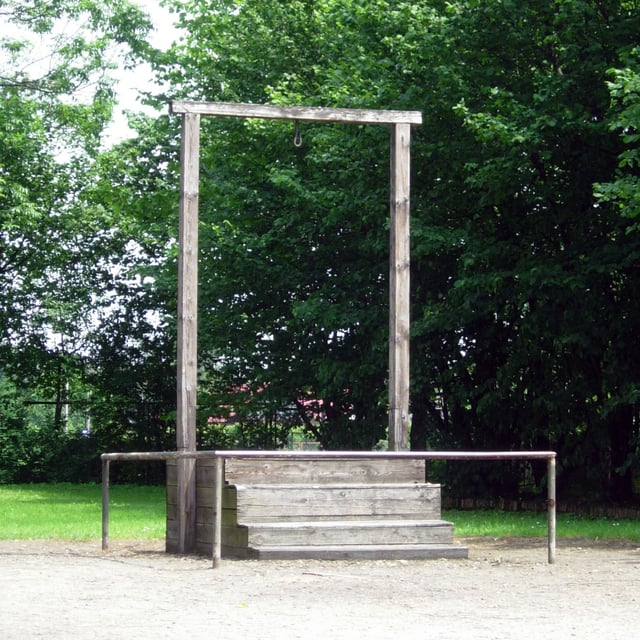
Gallows in Auschwitz I where Rudolf Höss was executed on 16 April 1947
Only 789 Auschwitz staff, 15 percent, ever stood trial;[271] most of the cases were pursued in Poland and, following them, the Federal Republic of Germany.[272] Female SS officers were treated more harshly than male; of the 17 women sentenced, four received the death penalty and the others longer prison terms than the men.[273]
Camp commandant Rudolf Höss was arrested by the British at a farm near Flensburg, Germany, on 11 March 1946, where he had been working under the pseudonym Franz Lang.[274] He was imprisoned in Heide, then transferred to Minden for interrogation, part of the British occupation zone. From there he was taken to Nuremberg to testify for the defense in the trial of SS-Obergruppenführer Ernst Kaltenbrunner. Höss was straightforward about his own role in the mass murder and said he had followed the orders of Heinrich Himmler.[275][8] Extradited to Poland on 25 May 1946,[276] he wrote his memoirs in custody, first published in Polish in 1951 then in German in 1958 as Kommandant in Auschwitz.[277] His trial before the Supreme National Tribunal in Warsaw opened on 11 March 1947; he was sentenced to death on 2 April and hanged in Auschwitz I, near crematorium I, on 16 April.[278]
On 25 November 1947, the Auschwitz trial began in Kraków, when Poland's Supreme National Tribunal brought to court 40 former Auschwitz staff. The trial's defendants included commandant Arthur Liebehenschel, women's camp leader Maria Mandel, and camp leader Hans Aumeier. The trials ended on 22 December 1947, with 23 death sentences, 7 life sentences, and 9 prison sentences ranging from three to fifteen years. Hans Münch, an SS doctor who had several former prisoners testify on his behalf, was the only person to be acquitted.[279]
Other former staff were hanged for war crimes in the Dachau Trials and the Belsen Trial, including camp leaders Josef Kramer, Franz Hössler, and Vinzenz Schöttl; doctor Friedrich Entress; and guards Irma Grese and Elisabeth Volkenrath.[280] The Frankfurt Auschwitz trials, held in West Germany from 20 December 1963 to 20 August 1965, convicted 17 of 22 defendants, giving them prison sentences ranging from life to three years and three months.[281] Bruno Tesch and Karl Weinbacher, the owner and the chief executive officer of the firm Tesch & Stabenow, one of the suppliers of Zyklon B, were executed for knowingly supplying the chemical for use on humans.[282]
Legacy

Auschwitz II gate in 1959
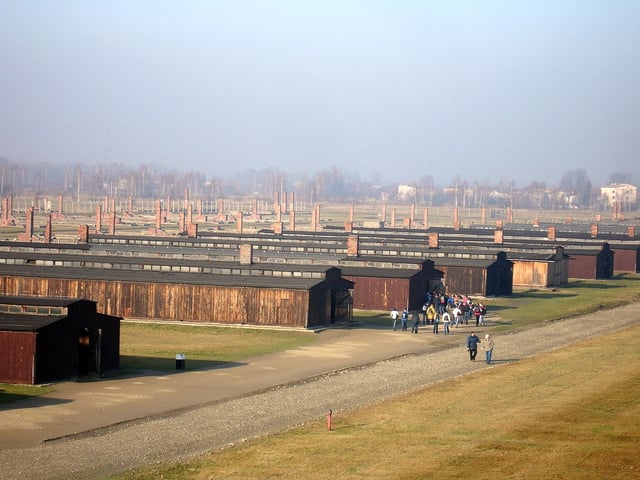
Barracks at Auschwitz II
In the decades since its liberation, Auschwitz has become a primary symbol of the Holocaust. Historian Timothy D. Snyder attributes this to the camp's high death toll and "unusual combination of an industrial camp complex and a killing facility", which left behind far more witnesses than single-purpose killing facilities such as Chełmno or Treblinka.[283] In 2005 the United Nations General Assembly designated 27 January, the date of the camp's liberation, as International Holocaust Remembrance Day.[284] Helmut Schmidt visited the site in November 1977, the first West German chancellor to do so, followed by his successor, Helmut Kohl, in November 1989.[285] In a written statement on the fiftieth anniversary of the liberation, Kohl described Auschwitz as the "darkest and most horrific chapter of German history".[286]
Notable memoirists of the camp include Primo Levi, Elie Wiesel, and Tadeusz Borowski.[206] Levi's If This is a Man, first published in Italy in 1947 as Se questo è un uomo, became a classic of Holocaust literature, an "imperishable masterpiece".[287][9] Wiesel wrote about his imprisonment at Auschwitz in Night (1960) and other works, and became a prominent spokesman against ethnic violence; in 1986, he was awarded the Nobel Peace Prize.[289] Camp survivor Simone Veil was later elected President of the European Parliament, serving from 1979 to 1982.[290] Two Auschwitz victims—Maximilian Kolbe, a priest who volunteered to die by starvation in place of a stranger, and Edith Stein, a Jewish convert to Catholicism—were later named saints of the Catholic Church.[291]
In 2017 a Körber Foundation survey found that 40 percent of 14-year-olds in Germany did not know what Auschwitz was.[292][293] The following year a survey organized by the Claims Conference, United States Holocaust Memorial Museum and others found that 41 percent of 1,350 American adults surveyed, and 66 percent of millennials, did not know what Auschwitz was, while 22 percent said they had never heard of the Holocaust.[294] A CNN-ComRes poll in 2018 found a similar situation in Europe.[295]
Auschwitz-Birkenau State Museum
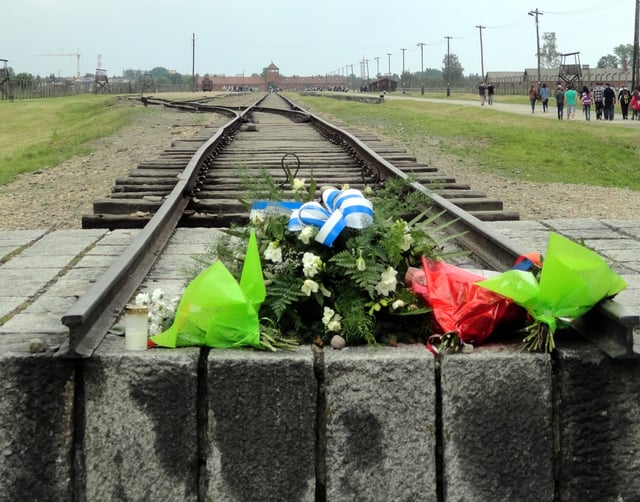
End of the rail track inside Auschwitz II-Birkenau

Israeli Air Force F-15 Eagles fly over Auschwitz II-Birkenau, September 2003.

Museum exhibit, 2016
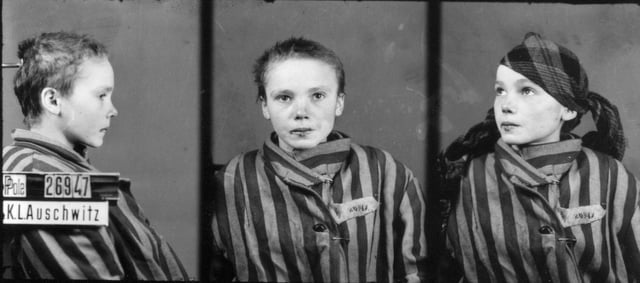
Czesława Kwoka, photographed in Auschwitz by Wilhelm Brasse
On 2 July 1947, the Polish government passed a law establishing a state memorial to remember "the martyrdom of the Polish nation and other nations in Oswiecim".[296] The museum established its exhibits at Auschwitz I; after the war, the barracks in Auschwitz II-Birkenau had been mostly dismantled and moved to Warsaw to be used on building sites. Dwork and van Pelt write that, in addition, Auschwitz I played a more central role in the persecution of the Polish people, in opposition to the importance of Auschwitz II to the Jews, including Polish Jews.[297] An exhibition opened in Auschwitz I in 1955, displaying prisoner mug shots; hair, suitcases, and shoes taken from murdered prisoners; canisters of Zyklon B pellets; and other objects related to the killings.[298] UNESCO added the camp to its list of World Heritage Sites in 1979.[299] All the museum's directors were, until 1990, former Auschwitz prisoners. Visitors to the site have increased from 492,500 in 2001, to over one million in 2009,[300] to two million in 2016.[301]
There have been protracted disputes over the perceived Christianization of the site. Pope John Paul II celebrated mass over the train tracks leading to Auschwitz II-Birkenau on 7 June 1979,[302] and called the camp "the Golgotha of our age", referring to the crucifixion of Jesus.[303] More controversy followed when Carmelite nuns founded a convent in 1984 in a former theater outside the camp's perimeter, near block 11 of Auschwitz I,[304] after which a local priest and some survivors erected a large cross—one that had been used during the pope's mass—behind block 11 to commemorate 152 Polish inmates shot by the Germans in 1941.[305][306] After a long dispute, Pope John Paul II intervened, and the nuns moved the convent elsewhere in 1993.[307] The cross remained, triggering the "War of the Crosses", as more crosses were erected to commemorate Christian victims, despite international objections. The Polish government and Catholic Church eventually agreed to remove all but the original.[308]
On 4 September 2003, despite a protest from the museum, three Israeli Air Force F-15 Eagles performed a fly-over of Auschwitz II-Birkenau during a ceremony at the camp below. All three pilots were descendants of Holocaust survivors, including the man who led the flight, Major-General Amir Eshel.[309] On 27 January 2015, some 300 Auschwitz survivors gathered with world leaders under a giant tent at the entrance to Auschwitz II to commemorate the 70th anniversary of the camp's liberation.[310][10]
Museum curators consider visitors who pick up items from the ground to be thieves, and local police will charge them as such. The maximum penalty is a prison sentence of ten years.[312] In June 2015, two British youths from the Perse School were convicted of theft after picking up buttons and shards of decorative glass from the ground near the area where camp victims' personal effects were stored. Curators said that similar incidents happen once or twice a year.[313] The 16-ft Arbeit Macht Frei sign over the main camp's gate was stolen in December 2009 by a Swedish former neo-Nazi and two Polish men. The sign was later recovered.[314]
In 2018 the Polish government passed an amendment to its Act on the Institute of National Remembrance, making it a criminal offence to make false suggestions of Polish complicity in the Holocaust, which would include referring to Auschwitz and other camps as "Polish death camps".[315] After discussions with Israel's prime minister, amid international concern that the law would stifle research, the Polish government adjusted the amendment so that anyone falsely accusing Poland of complicity would be guilty only of a civil offence.[316]
See also
Auschwitz Album
Auschwitz-Birkenau Foundation
Höcker Album
List of Nazi concentration camps
List of victims and survivors of Auschwitz
"Polish death camp" controversy

